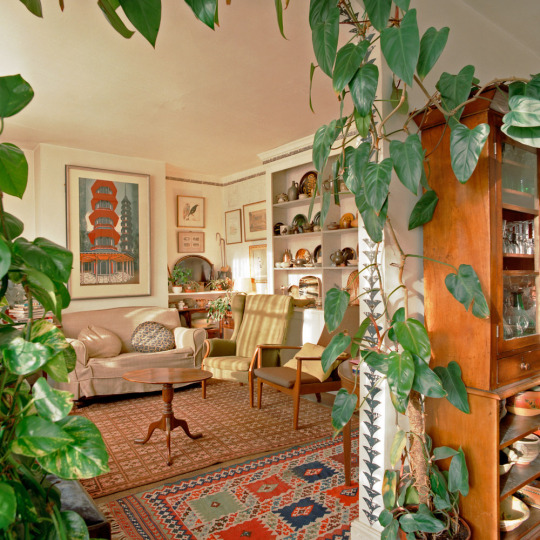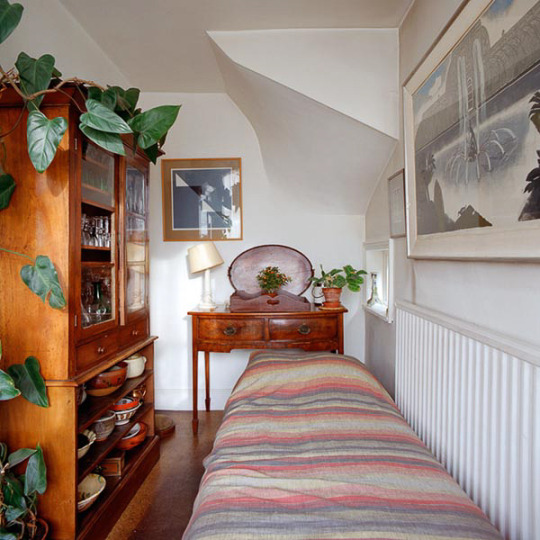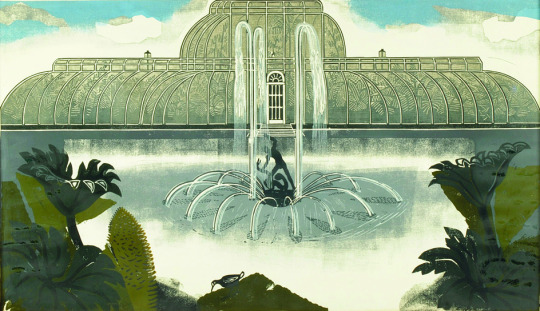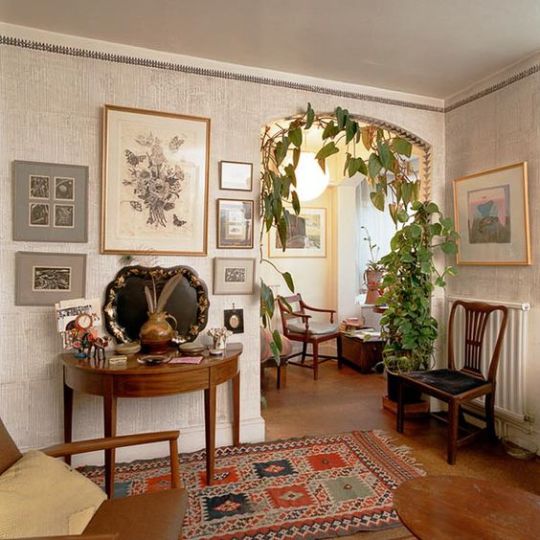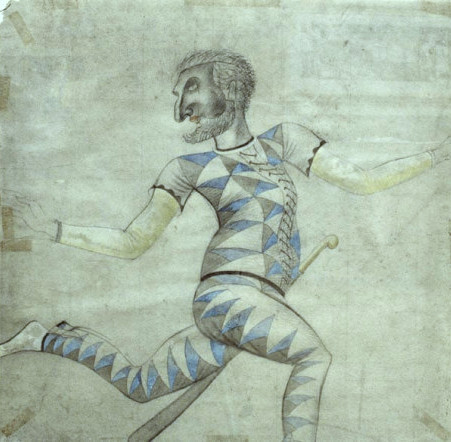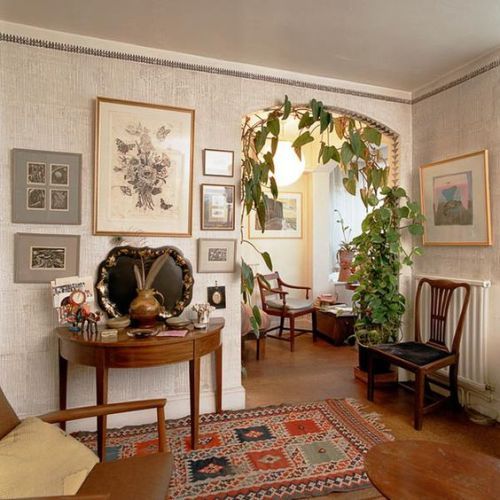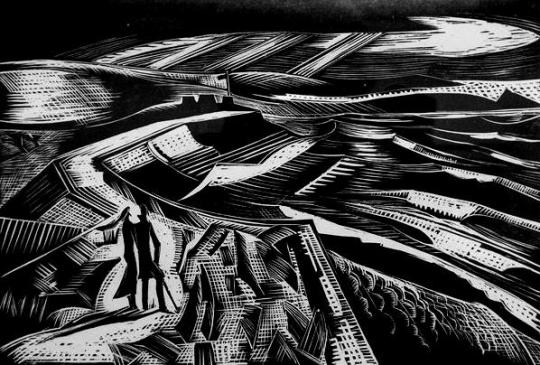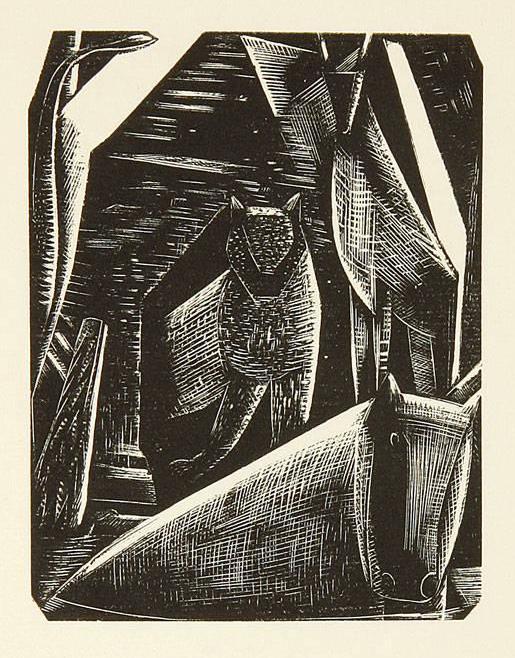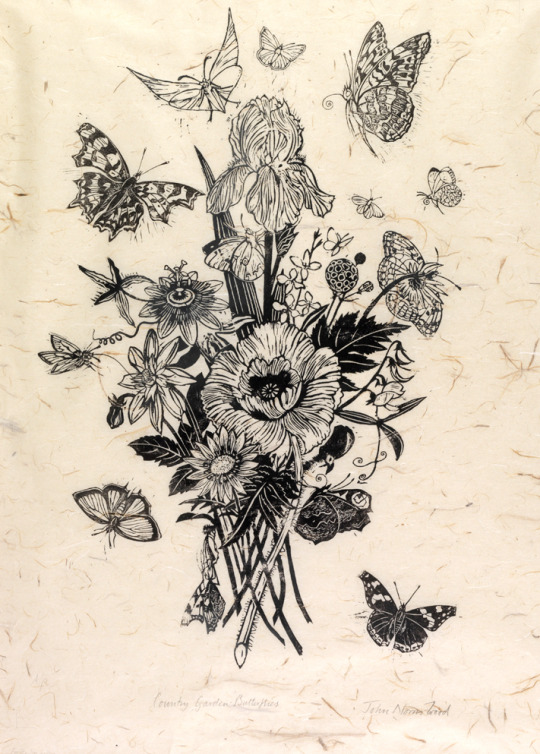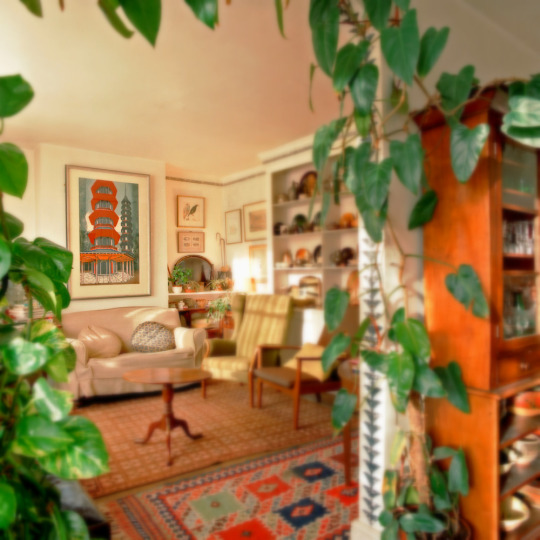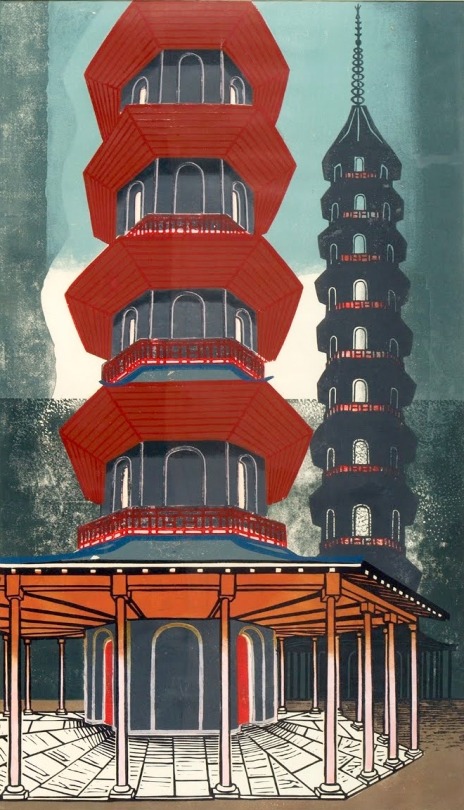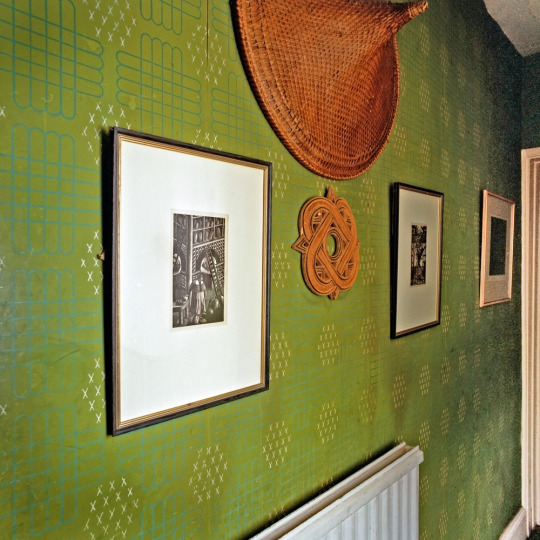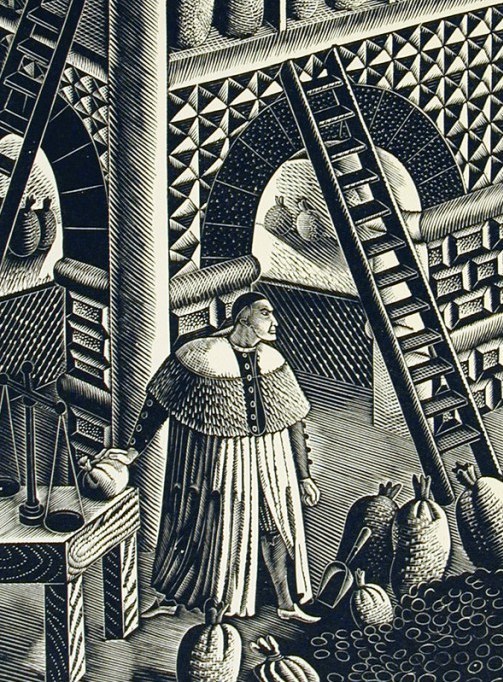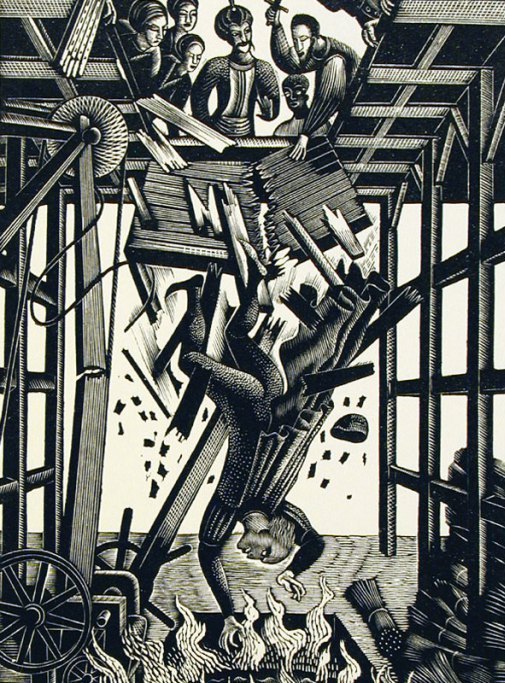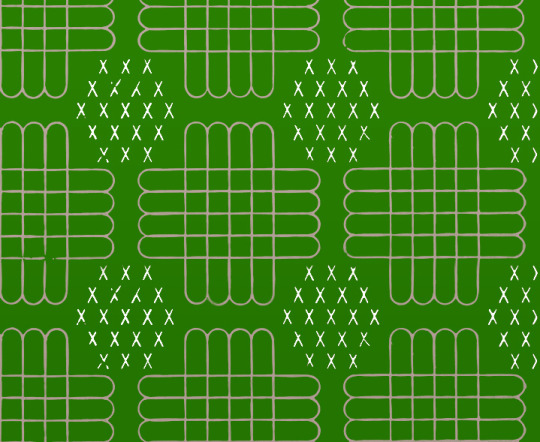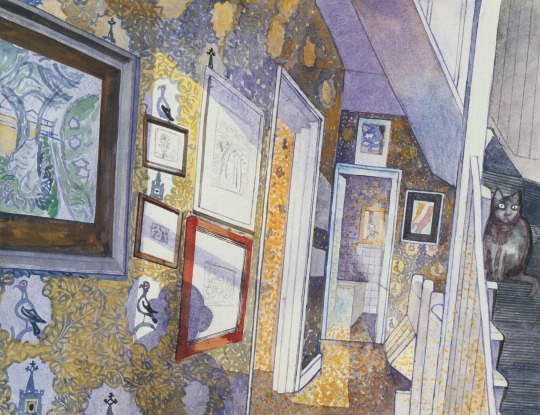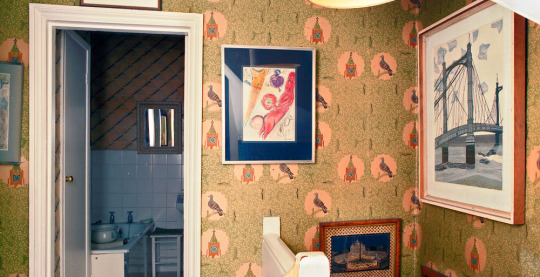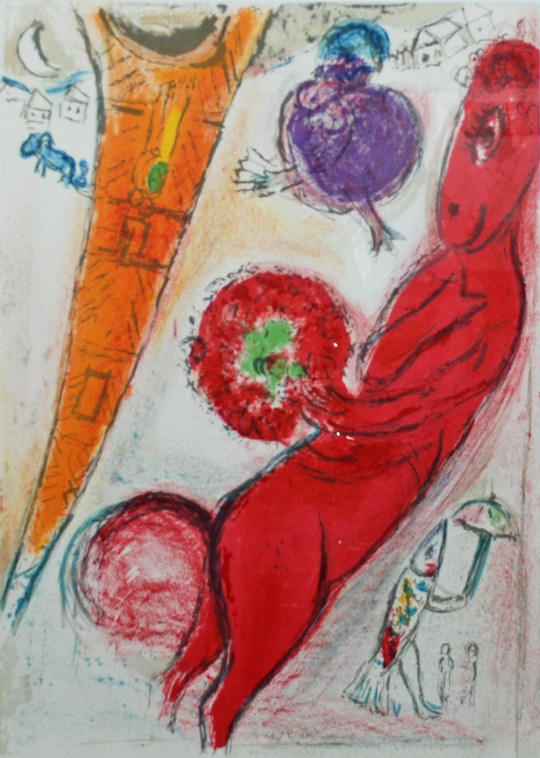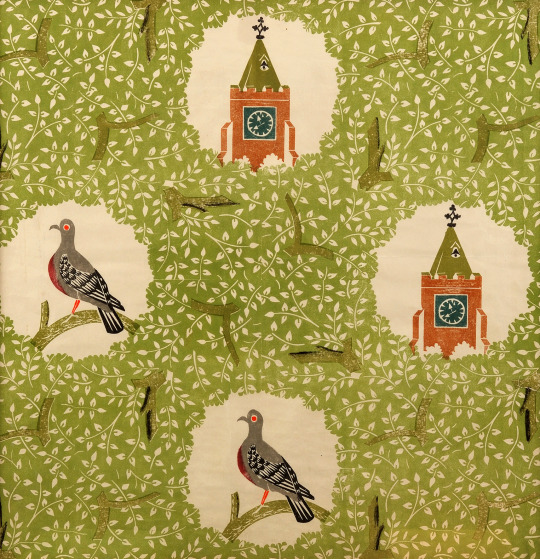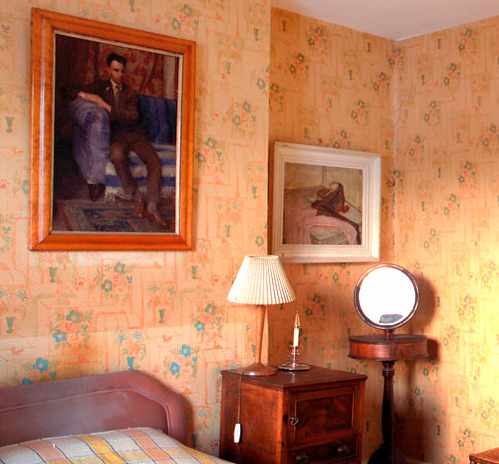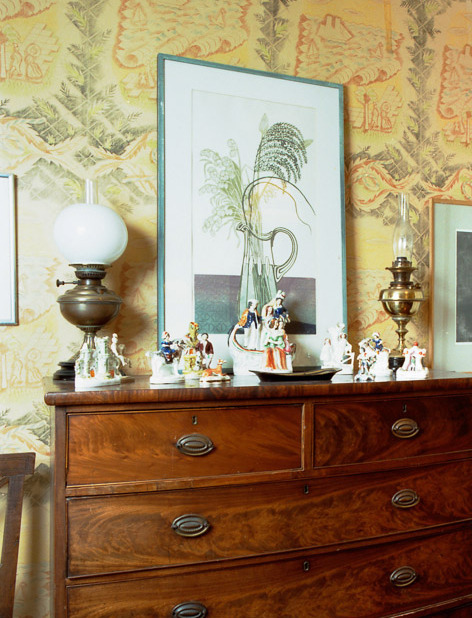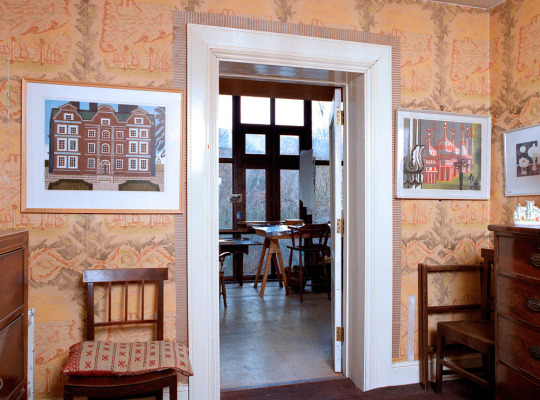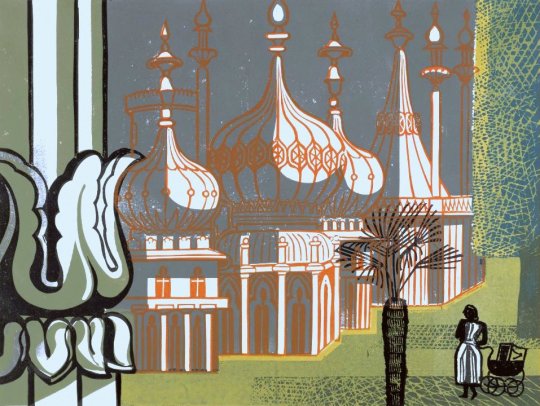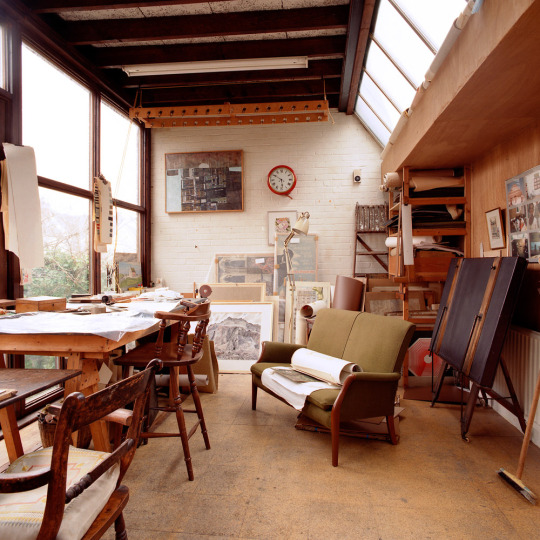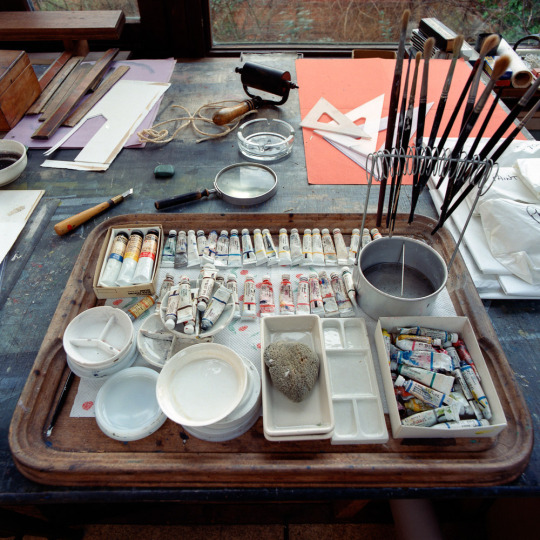Here is a documentary on Edward Bawden, Broadcast on Anglia TV in November 1983. It shows Bawden in his studio and house, talking of his war work and life in art and design.
Tag: Edward Bawden
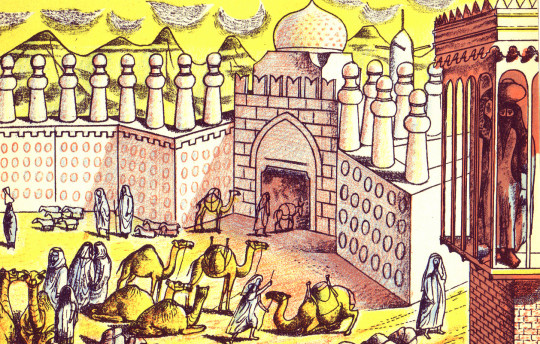
Edward Bawden – Lithograph for Travellers’ Verse, 1946.
This post is the story of Edward Bawden’s war work in the War Artists Advisory Committee (WAAC) as an artist and how he used the wartime drawings and paintings in illustration work, like the The Puffin Picture Book ‘The Arabs’ but other post-war commissions.
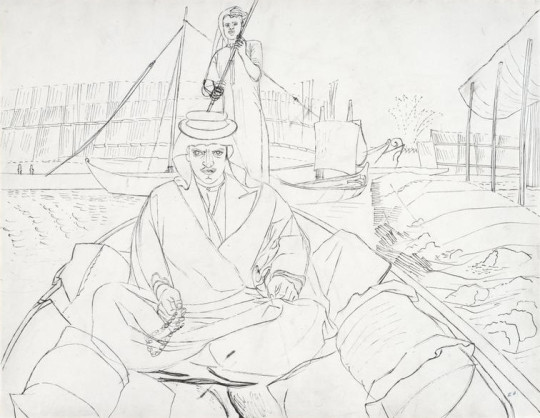
Edward Bawden – Shaikh Sharif al-Hafi, 1944.
When the Second World War broke out in 1939, Edward Bawden had already established a reputation as an illustrator, a comic draughtsman, a designer of typographical ornaments and patterns, a print-maker and a painter of landscapes in water-colour.
Bawden was appointed one of the first Official War Artists and was sent to join the British Army in France with Barnett Freedman and Edward Ardizzone. After being evacuated via Dunkirk, he was sent to the Middle East where he spent two years painting and drawing in Egypt, Libya, Sudan, Ethiopia, Eritrea, Syria, Iraq and Saudi Arabia. During his return journey to England, his ship was torpedoed; he then spent two months in a French internment camp before being released, and arrived in England safely, only to return to the Middle East, journeying around Cairo, Baghdad, Jeddah, Teheran, Ur of the Chaldees; he was drawing all the time, finally ending his travels in Rome. †

Edward Bawden – Shaikh Raisan al-Gassid, 1944.
The WAAC recommended in December 1939 that Bawden should be appointed as an official Air Ministry artist. In May 1940, after his return from France with the withdrawal from Dunkirk. Bawden expressed his regret at having had to leave, and Dickey reported him to be “extremely anxious to be sent out again to another scene of activity”. He departed for the Middle East in July. ♦
After the war Bawden stayed in Cheltenham while repairs and work were made to his home, Brick House; It was the only building in Great Bardfield to suffer from bomb damage, but Bawden also used the opportunity to make alterations and build a studio to the back of the house. The house was used and abused by the Home Guard during the war.
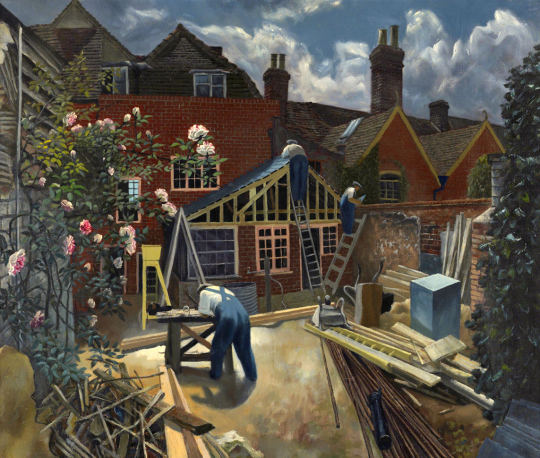
John Aldridge – Builders at Work, Brick House, Great Bardfield, 1946.
Bawden’s time as a war artist had given him the advantage of travel but also an abundance of sketch books and work that were still fresh in his mind in 1945. So it was in November of that year that Noel Carrington, the head of Puffin Books at Penguin was writing to his Allen Lane, his boss about Bawden and the planned book ‘The Arabs’:
12th November 1945
I have arranged for Bawden to meet you here on Wednesday afternoon at three o’clock, so you can discuss the alternative approaches to The Arabs book with him. As an illustrator, one method will suit him as well as another. ♥
From this meeting payments were settled and Bawden took on the job of illustrating the book. The text for the book was by Robert Bertram Serjeant, Nicknamed ‘Bob’. Serjeant was a Scottish scholar, traveller, and one of the leading Arabists of his generation.
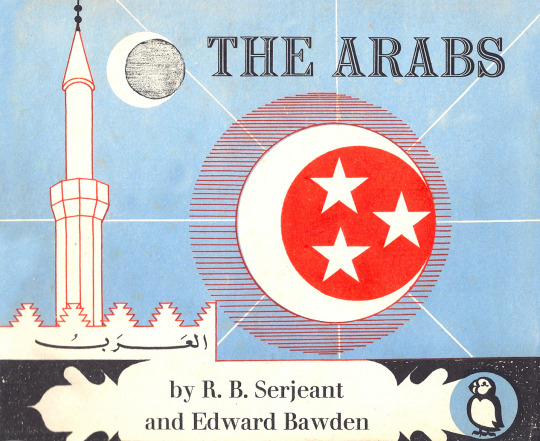
Edward Bawden – Front cover design for The Arabs, 1947.
Bawden to Carrington, 24 July 1946:
“The book is getting on slowly – I work upon the lithographs for a few hours every day, but because of the fine detail I find the work rather a strain on the eyes. In all I have finished one-fifth of the drawings but these include some of the most elaborate ones such as the two double spreads.’ ♥
As you can see in the image below, Bawden recycled some of his paintings from the war and used them in the making of the book. The man to the right – on the boat is ‘Shaikh Sharif al-Hafi’, pictured at the top of this post.
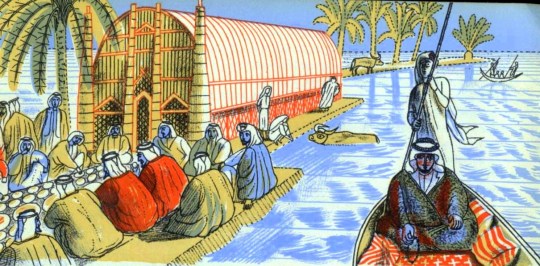
Edward Bawden – Detail from ‘The Arabs’, p18, 1947.
Below I have edited both images side-by-side and you can see how the line drawing has been simplified for the lithographic process.

Although ‘The Arabs’ became a factual book rather than the ‘story’ title Carrington intended, it is one of the highlights of the series. Bawden’s lithographs are as good as any he completed and the two full double page spreads are superb examples of his mastery of line; Curwen made a good job of the printing. ♥

Edward Bawden – Detail from The Arabs, p30, 1947
The text of ‘The Arabs’ doesn’t shy away from the Crusades and they are also illustrated as in the image above and below. The historical detail also takes in the history of the Arabic nations, how important they were during the silk road trade routes and how they declined after the European travellers sailed by boat beyond the Cape of Good Hope to China and India.

Edward Bawden – Double page spread from The Arabs, p30-31, 1947
Again, below and side by side are both the lithographed policeman from ‘The Arabs’ and the portrait Bawden painted during his war service. It really demonstrates the cheerful nature of his line drawings. It also shows how he used paintings and sketches to make the book as accurate as it could be.
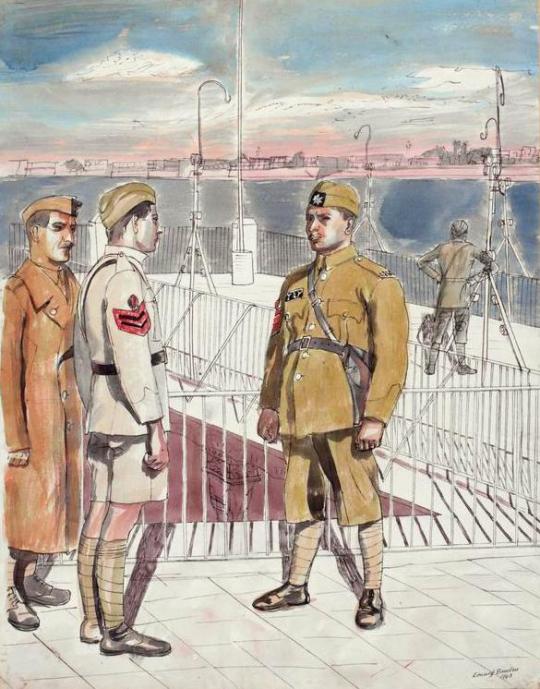
Edward Bawden – Baghdad: An Illustration of Iraqi Policemen’s Uniforms, 1943

Edward Bawden – Detail from ‘The Arabs’, p6, 1947
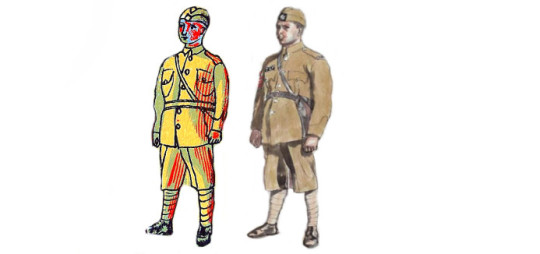
A Digital Edit of the book ‘The Arabs’ & Bawden’s War Portrait of the Policeman
The most beautiful of the two double-page illustrations is the Battle of al-Qādisiyyah, 636AD, when the Rashidun Caliphate overthrew the Sasanian Empire.

Edward Bawden – Double Page Spread from ‘The Arabs’ p26-27, 1947
The Sassanid Persian army, about 60,000 strong, fell into three main categories, infantry, heavy cavalry, and the Elephant corps. The Elephant corps was also known as the Indian corps, for the elephants were trained and brought from Persian provinces in India. The Arabic side is said to have been 36,000 strong, just over half, and yet they won.
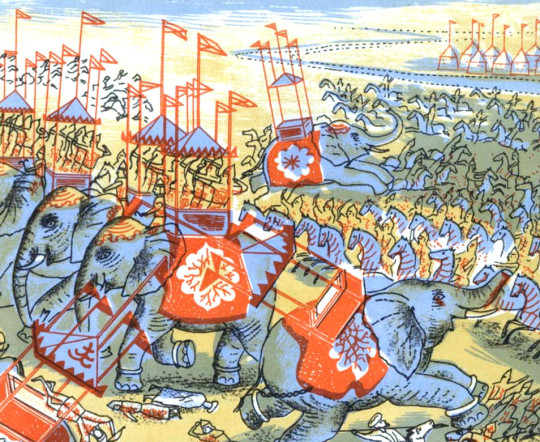
Edward Bawden – Double Page Spread from ‘The Arabs’ p27, 1947
Interestingly the book was never reprinted, and indeed could have been withdrawn and pulped! On the last pages of The Arabs, Bawden had illustrated ‘Muhammad mounted on Buraq’ ascending to the Seventh Heaven’. Obviously no one Bawden, Carrington or Lane had realised the grave offence that the depiction of the Prophet would cause.
The Cairo branch of W.H. Smith, which had ordered 5,000 copies, wrote requesting: ‘would there be any way of painting out the rider’.
Complaints flooded in and the Commonwealth Relations Office wrote to Penguin: The Puffin Picture Book No 61, entitled The Arabs, has on the last page a pictorial representation of the Prophet Mohammed and there have been in the Pakistan Press various letters protesting against this illustration.
As you no doubt know, any representation of the Prophet gives grave offence to Muslim sentiment. Although from a non-Muslim point of view such representations may appear harmless, it is none the less true that Muslim objections to representation of the Prophet in any form are based on sincere conviction.
You will, I am sure, appreciate that in inviting your attention to this matter we do not wish in any way to appear to be interfering with editorial responsibility. But we felt it right to draw your attention to the ill effects which an otherwise excellent little book may have in the Muslim world. Perhaps you would be good enough to bear this in mind should a reprint be under consideration?
One can only imagine the colour of the air when Allen Lane realised that his flagship Puffin was fatally flawed. Understandably The Arabs was never reprinted. ♥
I must add that after mentioning I was writing this post to a friend, they convinced me not to include the image of Mohammed in the blog too. If you wish to see the image you will just have to order a copy of the book to find out at your own offence.

Edward Bawden – Detail from ‘The Arabs’, p15, 1947
The painting below is of Mohammed Bin Abdullah El Atshan, King Ibn Saud’s representative at Rumaliya. This painting is a copy made in 1966 of a painting from 1943 made at the request of a British Petroleum executive when Bawden was painting a mural at the British Petroleum restaurant. The wall of petrol cans were given the BP logo at the executive’s suggestion.
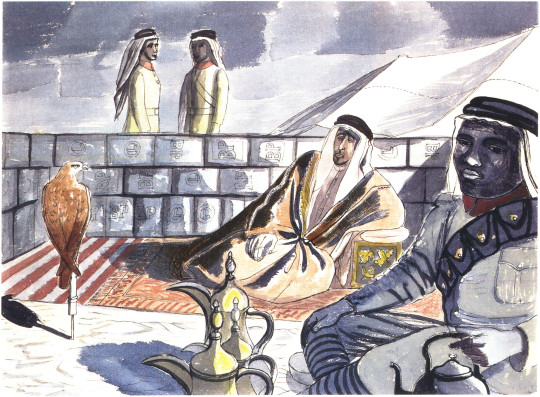
Edward Bawden – Mohammed Bin Abdullah El Atshan, 1966
What is more curious to me about the above retrospective painting is that parts of it turn up twice in the Puffin ‘Arabs’ book. The image below in colour has the hawk, coffee pots, the boy with water-pot and two men standing behind the wall. The black and white illustration below has the drawing of the sitter.
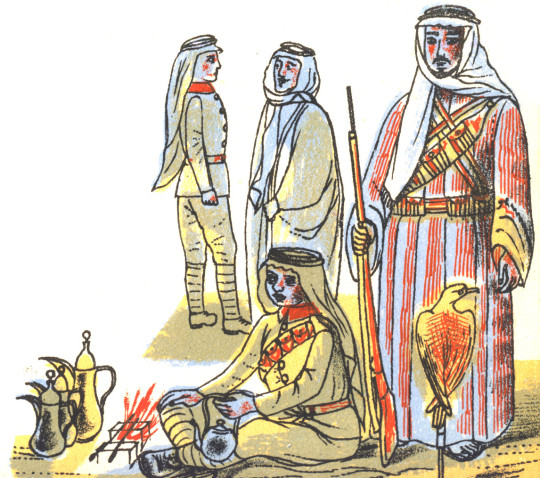
Edward Bawden – Detail from ‘The Arabs’, p7, 1947
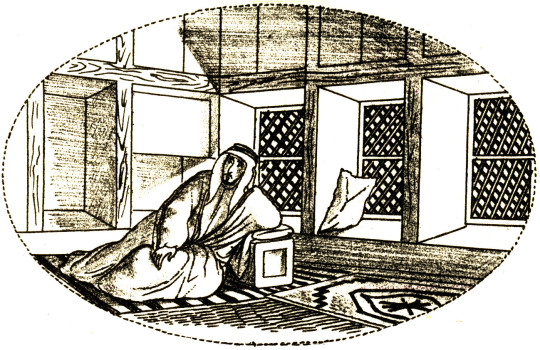
Edward Bawden – Detail from ‘The Arabs’, p25, 1947
Throughout 1946 Bawden was working on the illustrations for ‘The Arabs’ book, but it wasn’t published until 1947. Also in 1946 Bawden would illustrate a collection of poetry chosen by Mary Gwyneth Lloyd Thomas in a book called ‘Travellers’ Verse’ and he would be able to re-encounter his work of the middle east with his illustrations. These projects started to merge as parts of illustrations from his War Time Sketchbooks would end up in both.
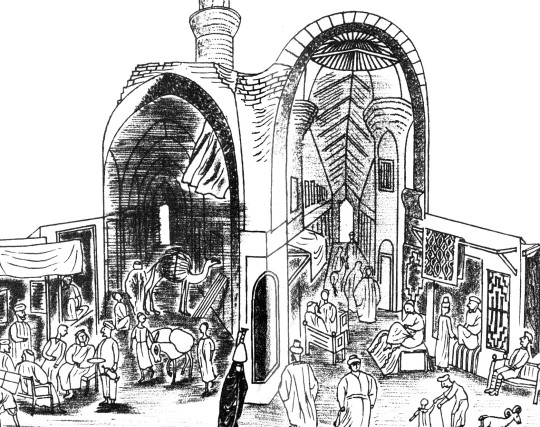
Edward Bawden – Detail from ‘The Arabs’, p12-13, 1947
Above is an illustration of a Market in Cairo from ‘The Arabs’ and below is an illustration of a market from ‘Travellers’ Verse’, albeit a more fantastical version. Because ‘The Arabs’ was to be accurate the illustrations are more or less from his war paintings, but the ‘Travellers’ Verse’ book he was able to have more fun with the illustrations and be more fanciful.

Edward Bawden – Detail from ‘Travellers’ Verse’, 1946
In the top right corner of the image above is the Mohammed Ali Mosque in Cairo in a simple line drawing from 1946. Below you can see it from one of Bawden’s paintings in 1941.

Edward Bawden – Cairo, the Citadel: Mohammed Ali Mosque, 1941
Bawden also illustrated the mosque, as below from the other side of the city
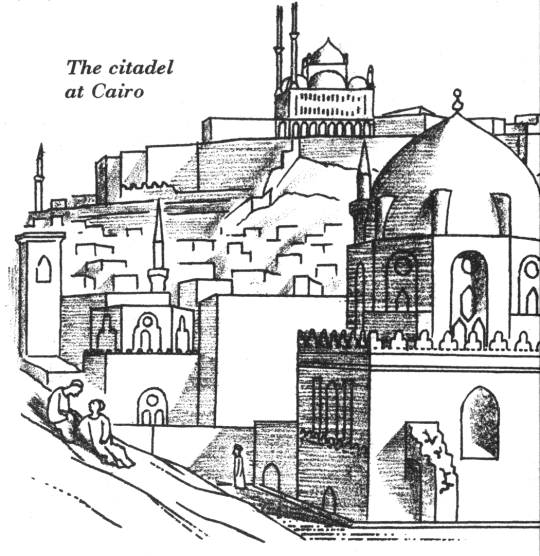
Edward Bawden – Detail from ‘The Arabs’, p23, 1947.
During his travels Bawden was able to stay in the centre of Cairo in the Citadel on his stay as he mentions:
Public relations could deal with journalists but they didn’t know how to deal with artists. They were puzzled and Major Asterly said ‘Why not go and stay in the citadel’, which I did and I found delightful. I made one or two drawings of the Mosque of Mohammed Ali. ♠
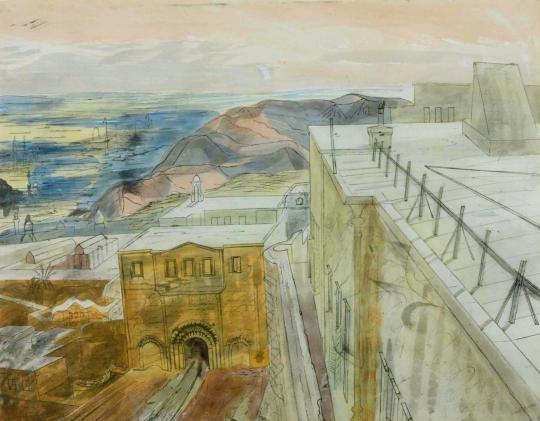
Edward Bawden – Cairo, the Citadel: On the Roof of the Officers’ Mess, 1941
In the ‘Travellers’ Verse’ illustrations we see the city life and a fantasy of life in the countryside, with Mosque towers and street cafes to the desert landscape and camp fires.
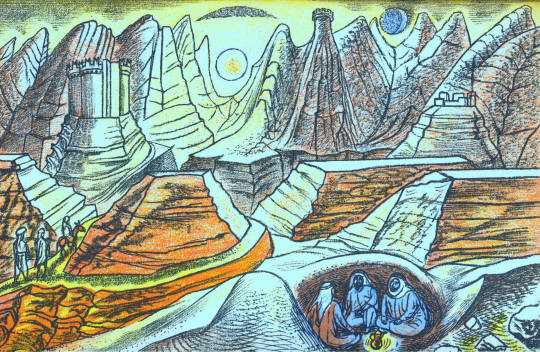
Edward Bawden – Detail from ‘Travellers’ Verse’, 1946
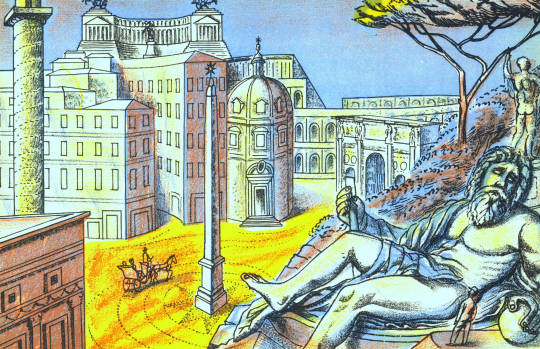
Edward Bawden – Detail from ‘Travellers’ Verse’, 1946
In fact Bawden would be able to use the war drawings of Greece and Rome for the other plates in the book. It seems that after Rome, Athens was a disappointment as Bawden mentions:
When I returned from Florence to Rome it was suggested that I go to Greece, so I went by air, it was the first time I had seen Greece I had been to Rome several times but I was very disappointing on the sight of Athens, it didn’t have the grandeur I was expecting. ♠
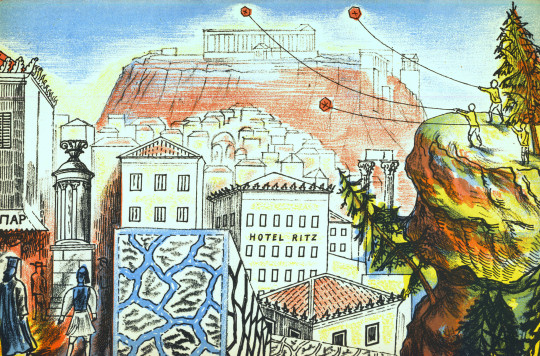
Edward Bawden – Detail from ‘Travellers’ Verse’, 1946
In ‘Travellers’ Verse’ the illustration of a huddled mass of bodies in a boat on a Paul Nash sea has none of the cheer the other images have. The poem being illustrated is ‘Don Juan and his tutor Pedrillo are shipwrecked.’ Bawden himself was shipwrecked during the war off the coast of West Africa on a ship from Cape Town to London. It is another translation of his wartime experiences.

Edward Bawden – Detail from ‘Travellers’ Verse’, 1946
The Laconia was nearing the Equator in temperatures of 110 degrees Fahrenheit when, at 8pm on the evening of 12th September, 1942, it was hit twice below water level by torpedoes from the German U-boat U156 under the command of Werner Hartenstein.
Bawden with typical sangfroid resigned himself to death by drowning: ‘so I thought I’d wander round a bit and have a look. I went down to my cabin – I’d bought my wife a watch and thought I might as well go down with the watch as not.’ Then, ‘on returning from my cabin I saw ropes hanging down on the side where life-boats had been lowered and standing by one of these I was joined by a major. ‘After you, Sir’ I said. As he descended there was a splash. Sliding down the next ropes I found myself being gripped and guided into a boat. A few minutes later all the boats pulled away to a safe distance and there we sat waiting, still and silent and tense for the sound of the ship’s final end. ‡
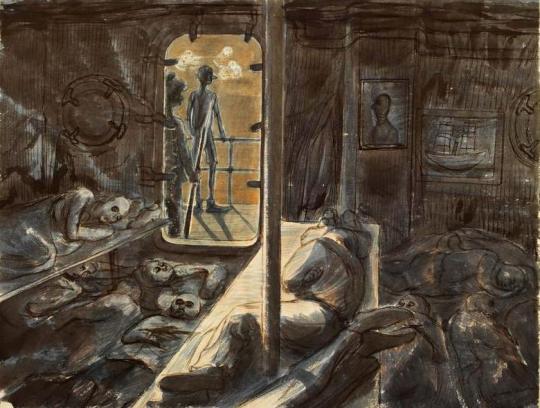
Edward Bawden – Rescued at sea by the French warship Gloire, 1943.
The survivors were rescued by a French ship who were unkind to them and then taken to an internment camp in Casablanca where they stayed for two and a half months until rescued, this time by the Americans, who were kind. As a British citizen he was shipped to Norfolk, Virginia, USA before being shipped back to London.
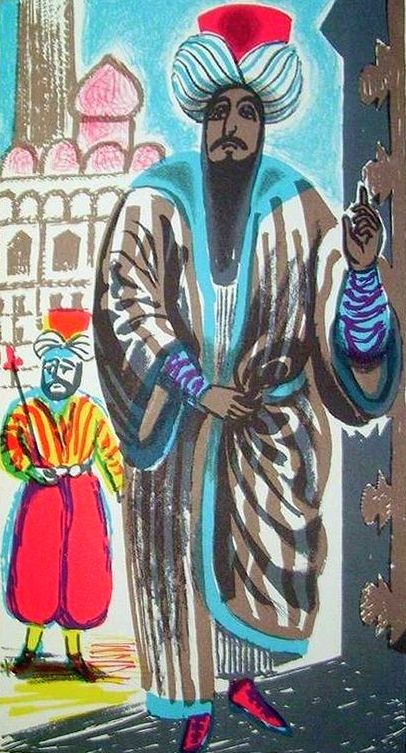
Edward Bawden – Illustration from Vathek, 1958.
Many years after the war Bawden illustrated Beckford’s ‘Vathek, an Arabian Tale’ for the Folio Society in 1958, I find these illustrations rather weak personally, I can’t work out if he wanted to change to a looser style of lithographic illustration or if they were dashed out for the money, while technically good with colour layering, the end result in my view is poor. I rather suspect the commission came in conjunction with a larger one – ‘The Histories of Herodotus of Halicarnassus’ for the Limited Editions Club, a company like the Folio Society, but American; For them Bawden provided over 100 illustrations in a two volume book set.
He would illustrate Johnson’s ‘Rasselas’ in 1975 for the Folio Society with happier outcomes compared to ‘Vathek’, though not totally Arabian, it is a fantasy of travel.
To conclude the various Arabic styles of Bawden we should end with the giant mural for BP’s restaurant at Britannic House. The best of Bawden’s murals, using Islamic designs and architectural drawings to bold outcomes, it uses blocks of colour and pattern design much like one of his linocuts.
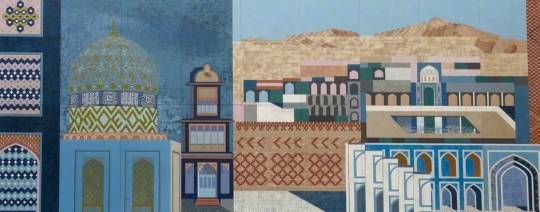
Edward Bawden – Fantasy on Islamic Architecture (Left Panel), 1966
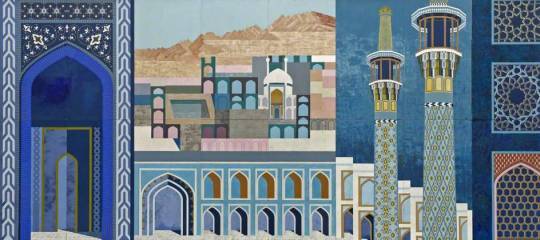
Edward Bawden – Fantasy on Islamic Architecture (Right Panel), 1966
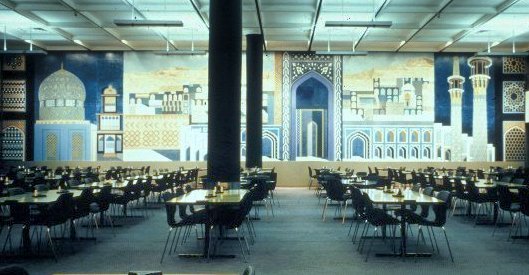
A view of the Dining Room in Britannic House.
† Ruari McLean , Edward Bawden War Artist & His Letters, 1989
‡ Malcolm Yorke – Edward Bawden and His Circle, 2015.
♠ 4622 Edward Bawden Audio Tape, IWM, 1980.
♣ R.B. Serjeant and Bawden Edward – The Arabs, 1947.
♥ Joe Pearson – Drawn Direct to the Plate, 2010
♦ Edward Bawden 1939-1944, ART/WA2/03/044/1
In the past two weeks I have posted about Edward Bawden and his home in the twilight of his life. This is the third and last of these posts.
The artists of Great Bardfield all reacted to their surroundings by making paintings or prints of the area that they lived, so when Edward Bawden moved to Saffron Walden in 1970, he naturally used local places in his artworks, from Bridge End Garden’s to the church.
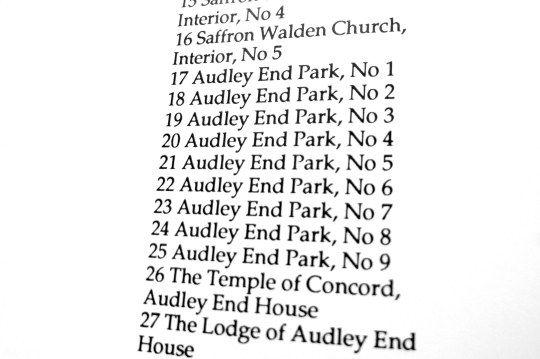
Exhibition list from The Fine Art Society Ltd show 20/ii/1978 – 10/iii/1978.
One of the biggest tourist attractions to Saffron Walden and one of the most prominent buildings in East Anglia is Audley End house and its gardens. It also was very convenient being twenty minuets walk from Bawden’s house, even for an older man.
In 1973 Bawden made a large lino cut of Audley End, a complex task to complete, with the regimented architecture of the building it is one of the more technical linocuts Bawden completed.

Edward Bawden – Audley End House, 1973
The watercolours Bawden completed where many but show off the wonderful and complex landscape of the Audley End Park, it’s follies and the trees.
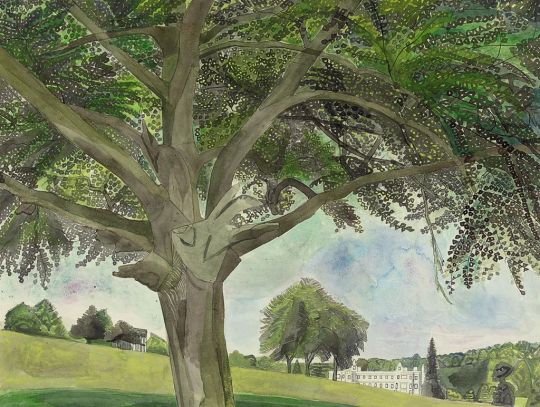
Edward Bawden – The Temple of Concord, Audley End, 1975
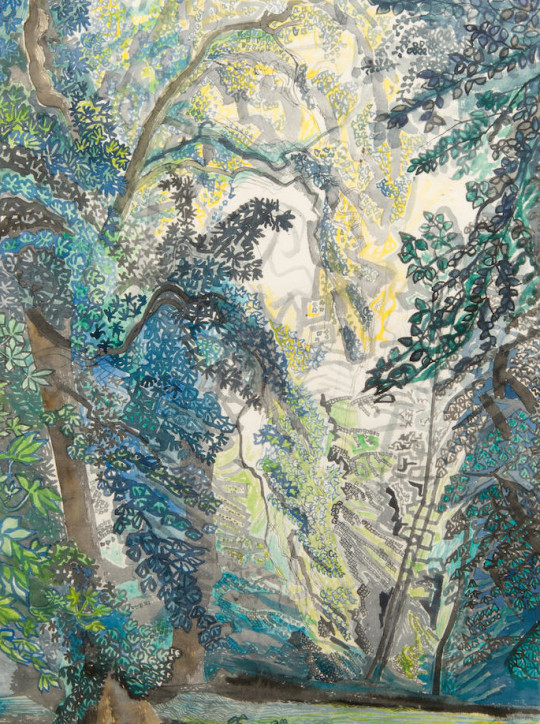
Edward Bawden – Audley End Park III, 1975.
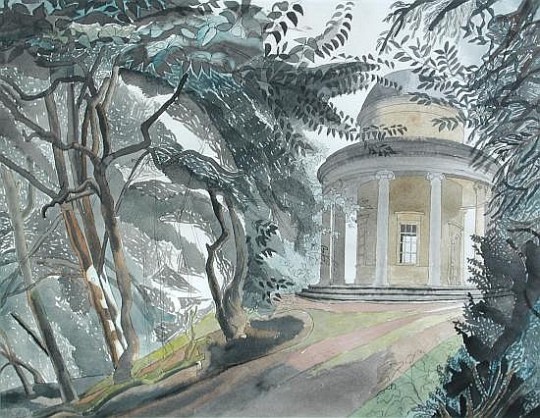
Edward Bawden – The Adam Temple, Audley End, 1978
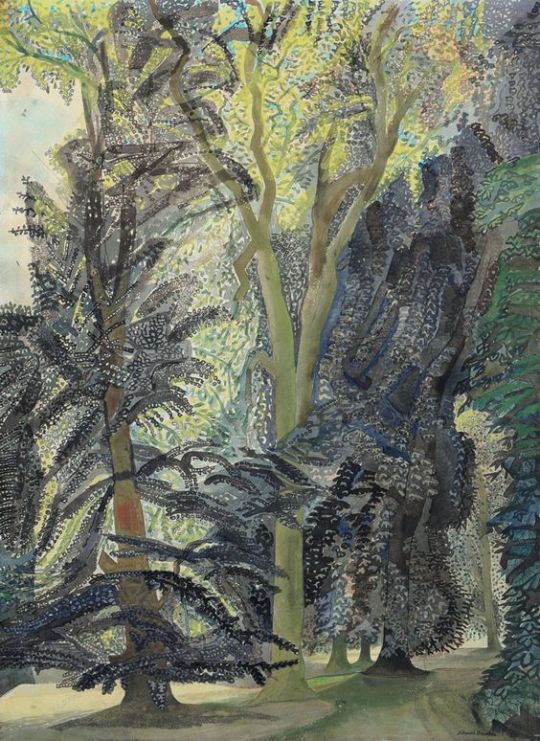
Edward Bawden – Ringwood, Audley End, 1975

Edward Bawden – Ringwood, Audley End, 1975
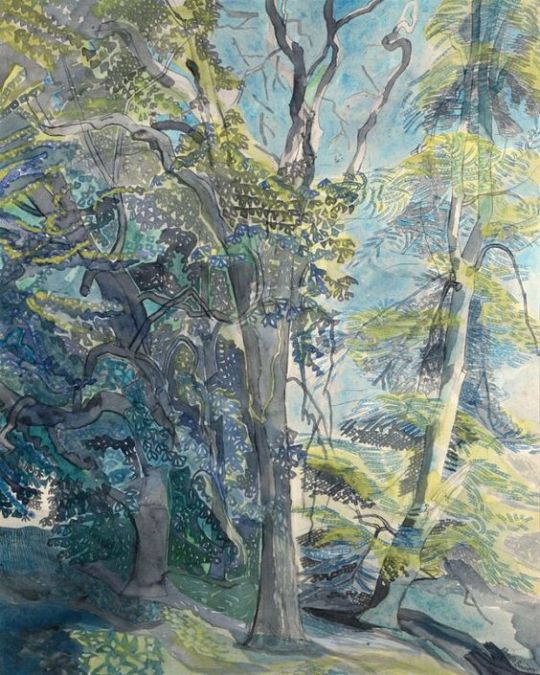
Edward Bawden – Ringwood, Audley End, 1975
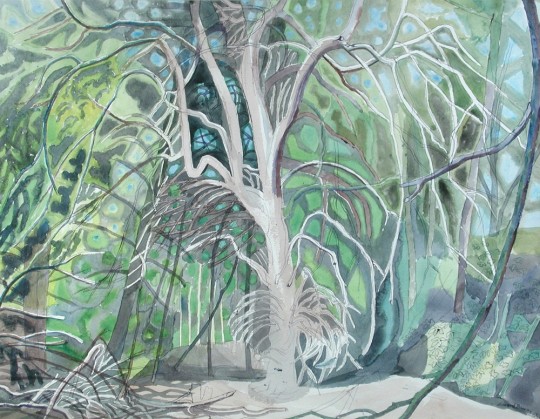
Edward Bawden – Ringwood, Audley End, 1975

Edward Bawden – In Audley End Park, 1978

Edward Bawden – Audley End, 1978
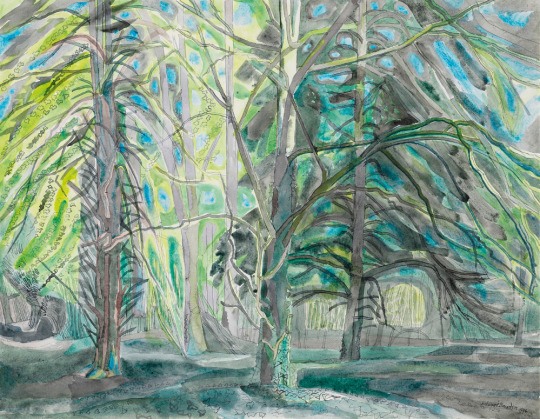
Edward Bawden – Ringwood V, Audley End, 1975
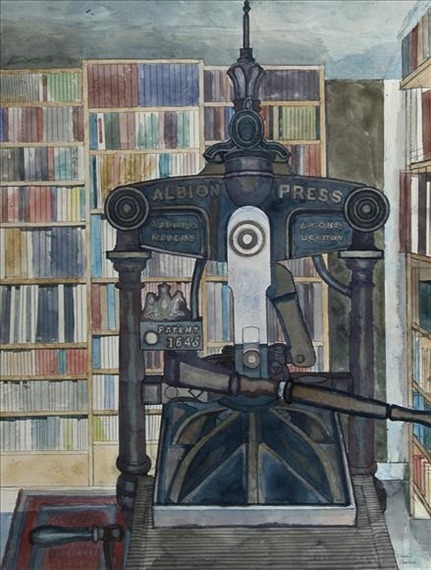
Edward Bawden – Press and Books, 1979
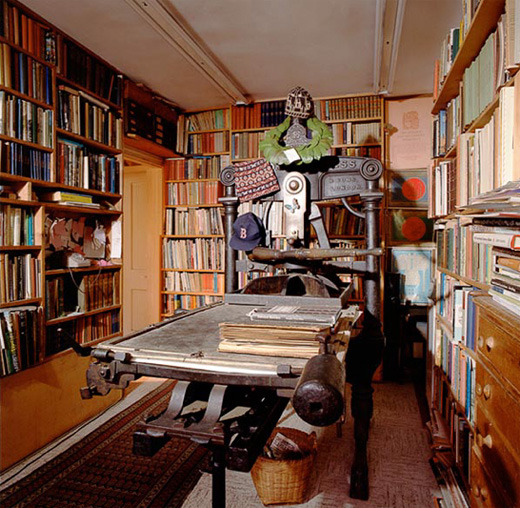
The Print Room – 2 Park Lane, Saffron Walden, 1989
Edward Bawden is best known as one of the Great Bardfield artists in the 1950s, but as the artists either divorced or moved away to other villages and towns, Edward and his wife Charlotte were the only important artists left in the village in the late 1960s, (other than John Aldridge). With health problems and old age, Bawden and his wife decided to move to Saffron Walden. Charlotte sadly died just before moving into 2 Park Lane, Saffron Walden, but Edward honoured the sale and moved alone in 1970.
With the blank canvas of a new house, Bawden set to work decorating the rooms with his own wallpapers and setting up the possessions brought from Brick House into this new home. A studio was built on the back of the property with large windows and a trap door for large works to enter the studio without going through the house. After ten years living at the property Bawden’s health became worse with old age.
For most of the year he was more house-bound than he had ever been and this forced him into new subject areas. In 1986 he began a series of watercolours which depicted his own rooms, his studio, his plants, his glowing oriental carpets, his gas fire, his cat Emma Nelson, and, eventually, this most private of men made his own face the subject of his art.
This focus on home and the cat was becoming obvious when one looks at the exhibition picture list for ‘The Private World of Edward Bawden’ by the Fine Art Society in 1987.
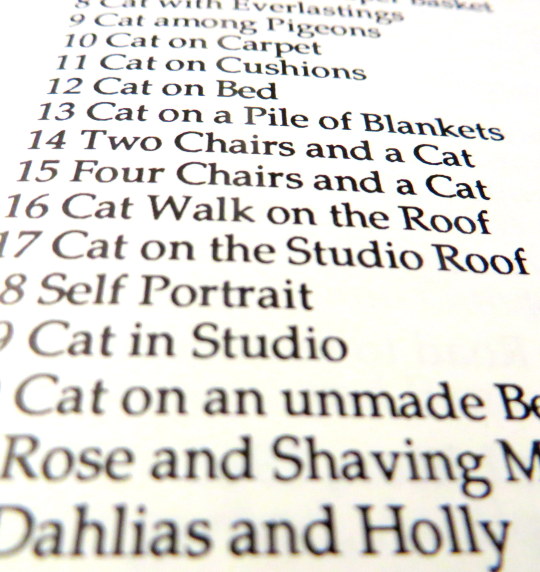
Works list at ‘The Private World of Edward Bawden’ Exhibition, 1987. †
The Tate now possess two of the pictures from this show, “Emma Nelson by the Fire” and “Roses and Rue”, both pictures with the cat in. In the magazine ‘House and Garden’ (December 1987) Edward Bawden gave an interview about his cat:
No cat will suffer from being lifted up and dropped into an empty space intended for her to occupy; that procedure led inevitably to Emma, tail up, walking away at once, so I had to wait patiently until Emma had enjoyed a good meal of Coley and was ready to choose her daily sleeping place, wherever it might be. I would then spring into action with a colour and colour. ‡
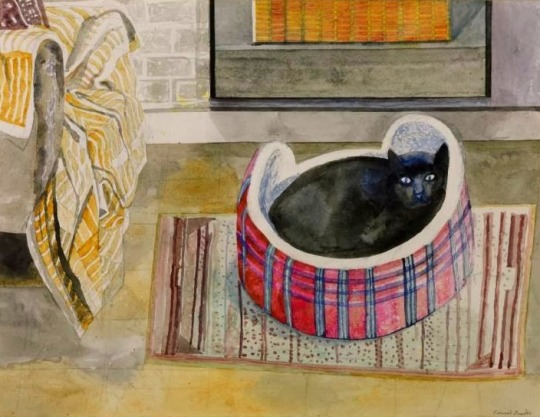
Edward Bawden – Emma Nelson by the Fire, 1987
When the Tate wrote to Richard Bawden for more information on the painting they had acquired (Emma Nelson by the Fire) in 1991 he responded with this letter:
Although the house is covered with his early wallpapers, yellowed by nineteen years of nicotine, his studio being an extension was painted brick and not alas the wallpaper known as Rustication [1938–9] … The nasty tartan fur lined cat ‘basket’ came from the local charity shop … The rug on the floor used to be in the bathroom at Brick House, Gt. Bardfield, bought by my mother on a trip to Portugal or elsewhere. The curtain draped over the armchair hung in the spare room at Gt. Bardfield, and I am fairly sure must have been designed by Marianne Straub who lived in the cottage directly across the road and who at the time, I mean the late fifties, was chief designer at Warners. The cushion, at a guess because there is not much showing, was probably covered by a piece of hand blocked cotton by Barron & Larcher who had a studio in Painswick until the outbreak of war. The gas fire I cannot help you with, only I think Edward has improved its design. ♠
The letter illustrates a lifetime of collecting and friendships in the possessions Bawden owned. In next week’s post I will elaborate more on this theme but I will leave you with some of the many images Bawden painted of his home and of his cat.
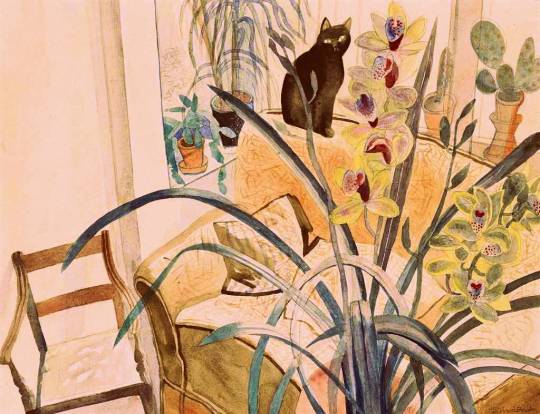
Edward Bawden: Cat and an Orchid, 1987
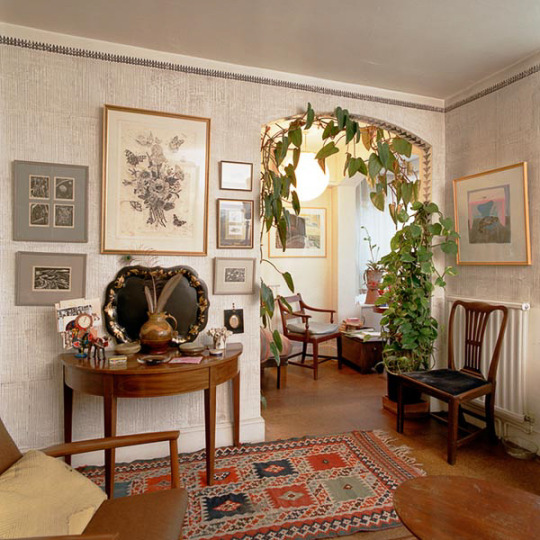
The Living Print Room – 2 Park Lane, Saffron Walden, 1989
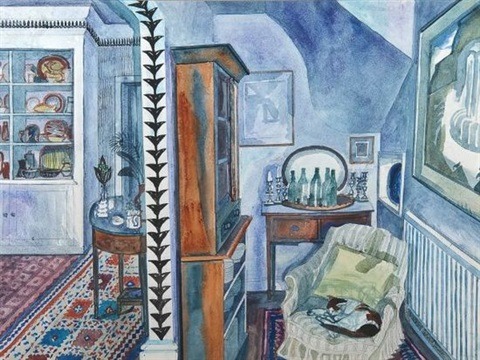
Edward Bawden – Cat on Cushions. 1985
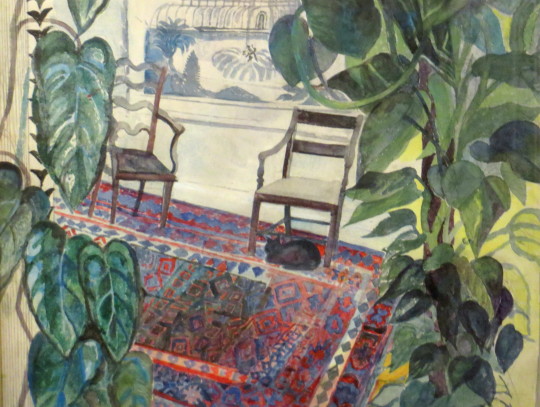
Edward Bawden – The Living Room, 1985 (Featured in the R.A. ‘85 Summer Exhibition)
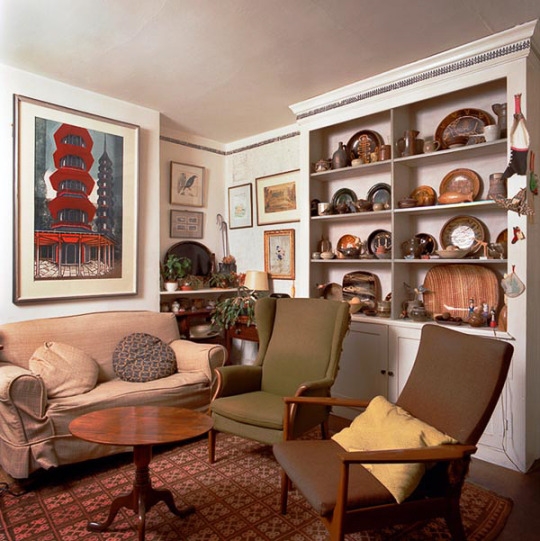
The Living Room – 2 Park Lane, Saffron Walden, 1989
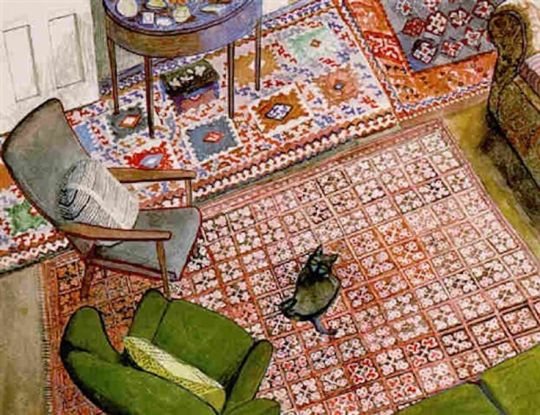
Edward Bawden – Cat on the Carpet, 1987
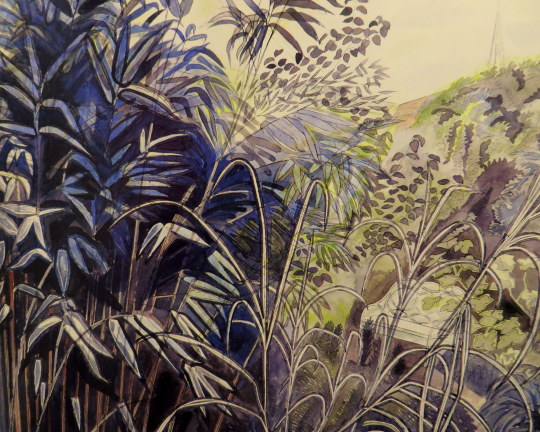
Edward Bawden – Bamboos and Garden Seat, 1979
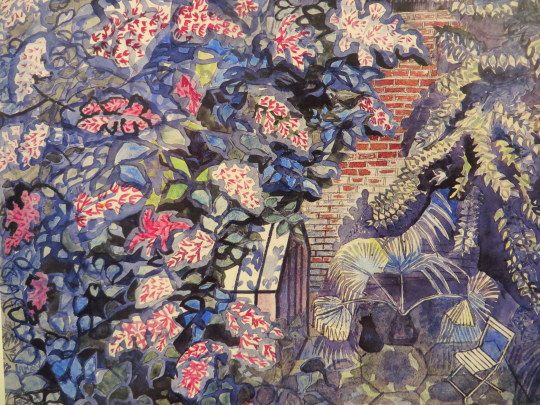
Edward Bawden – Cat and Greenhouse, 1986
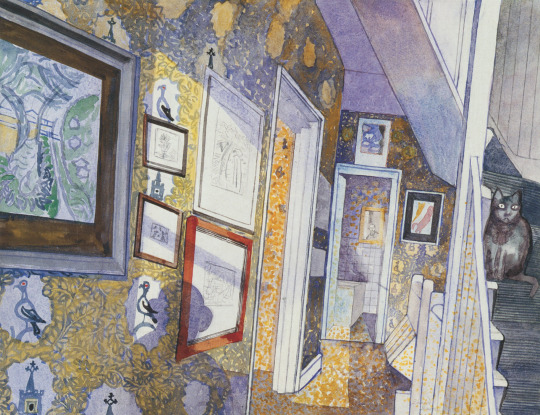
Edward Bawden – Cat Among Pigeons, 1986.
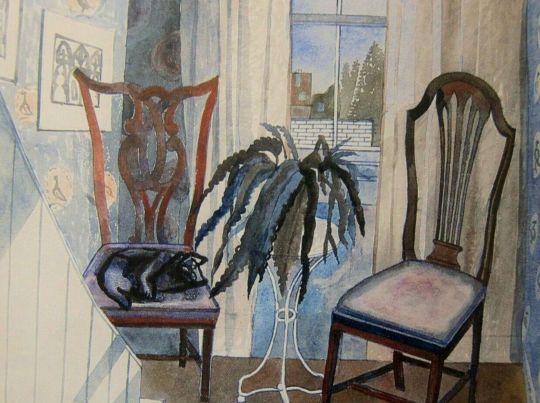
Edward Bawden – Two Chairs and a Cat, 1986
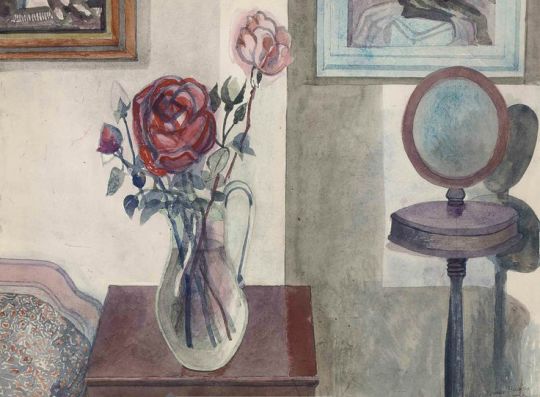
Edward Bawden – Rose and Shaving Mirror, 1987

Edward Bawden – Cat on A Pile of Blankets, 1985
d
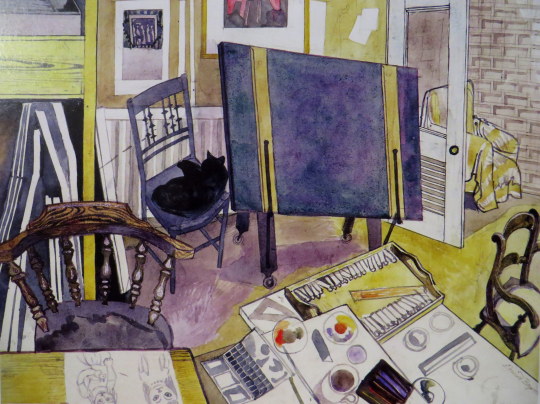
Edward Bawden – Four Chairs and a Cat, 1987
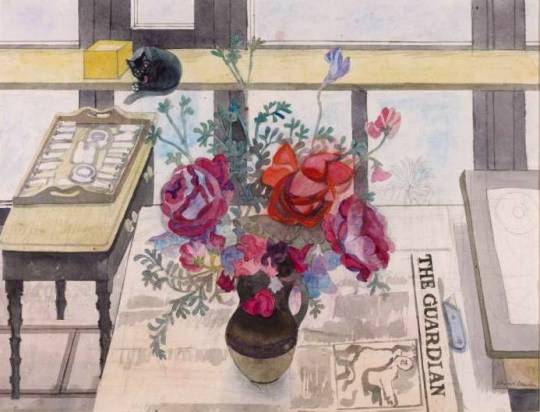
Edward Bawden – Roses and Rue, 1987
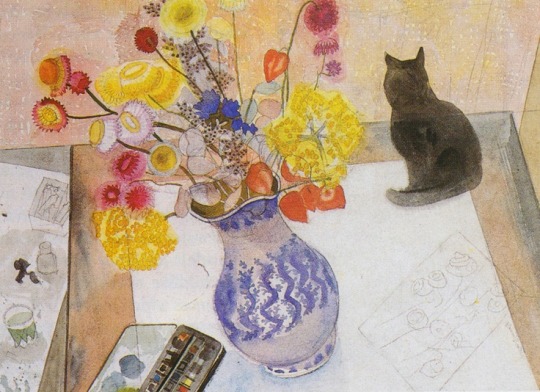
Edward Bawden – Cat with Everlastings, 1987
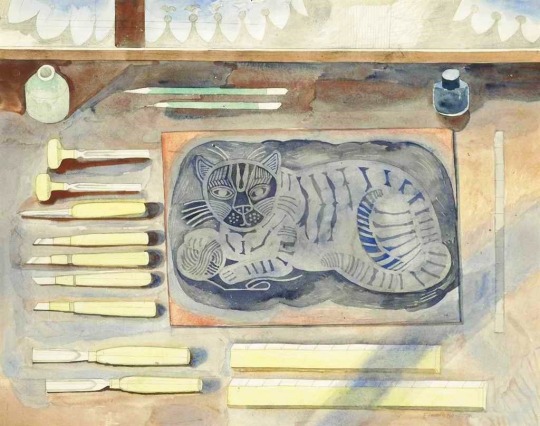
Edward Bawden – Play With Me, 1983
The linocut on the table when finished and editioned was also called Play with Me, now famous for being a Cushion from the Fry Gallery.

Edward Bawden – Cap and Base, 1983
Bawden printed these designs onto ceramic tiles, presumably for himself.
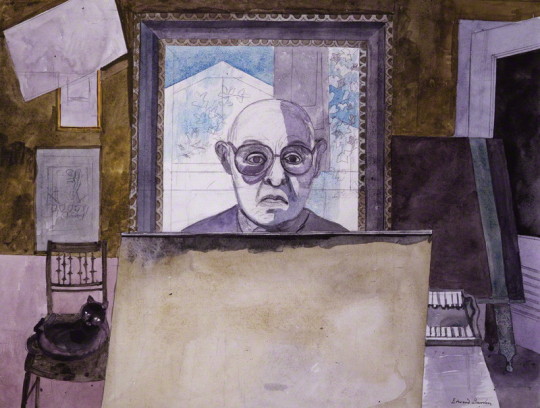
Edward Bawden – Self-Portrait, 1986
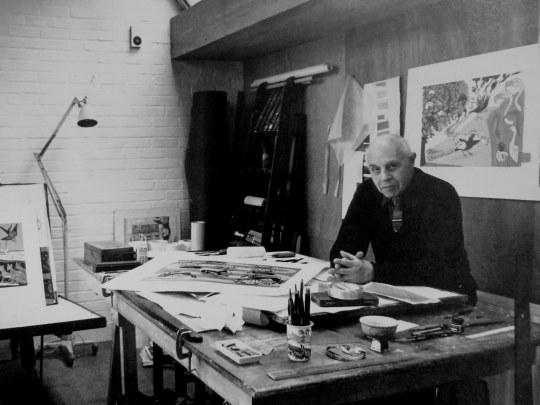
Jorge Lewinski – Edward Bawden in his Studio, 1978.

Edward Bawden – Cat on a settee, 1987


Edward Bawden – Daffodils, 1988
Below is one of the last watercolours Bawden painted and left unfinished and the linocut also unfinished.

Edward Bawden – Daffodils, Unfinished, 1989
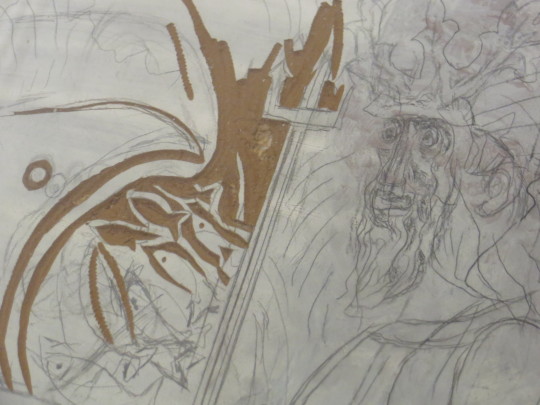
Edward Bawden – Poseidon Linocut, Unfinished 1989
Bawden was working on this linocut on November 21st 1989 before attending for lunch, where he died at table. ♥
† Fine Art Society, The Private World of Edward Bawden’ Exhibition Booklet, 6-30 April, 1987
‡ House and Garden’ (December 1987) Edward Bawden
♠ Tate Gallery: Illustrated Catalogue of Acquisitions 1986-88, London 1996.
♣ Malcolm Yorke – Edward Bawden and his Circle.
♥ Fry Gallery Label 2018
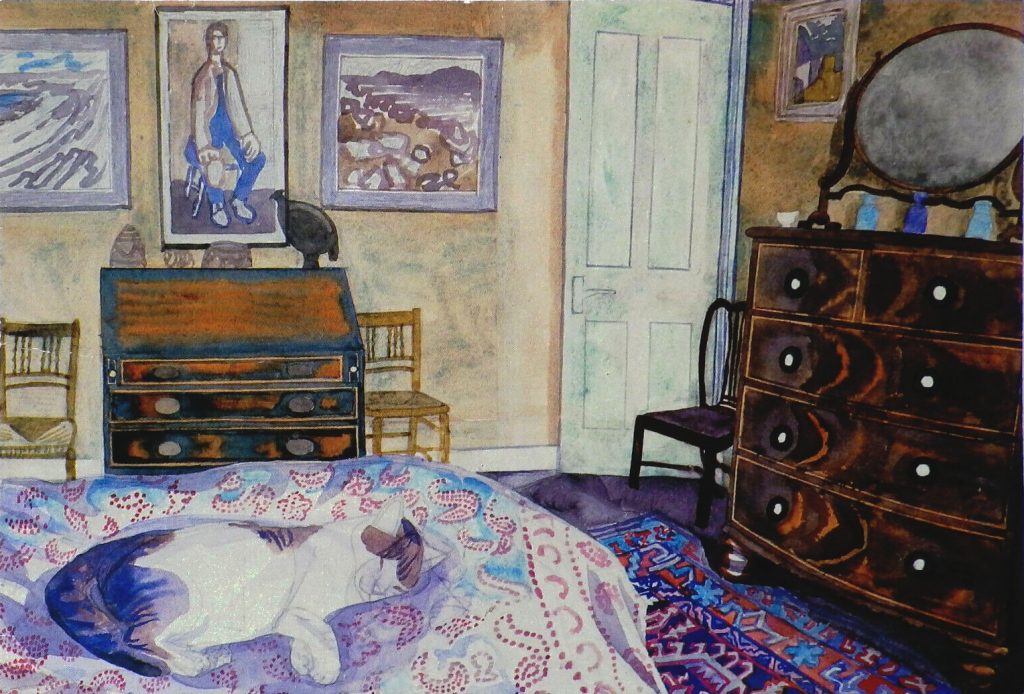
Edward Bawden – His Master’s Room, 1984
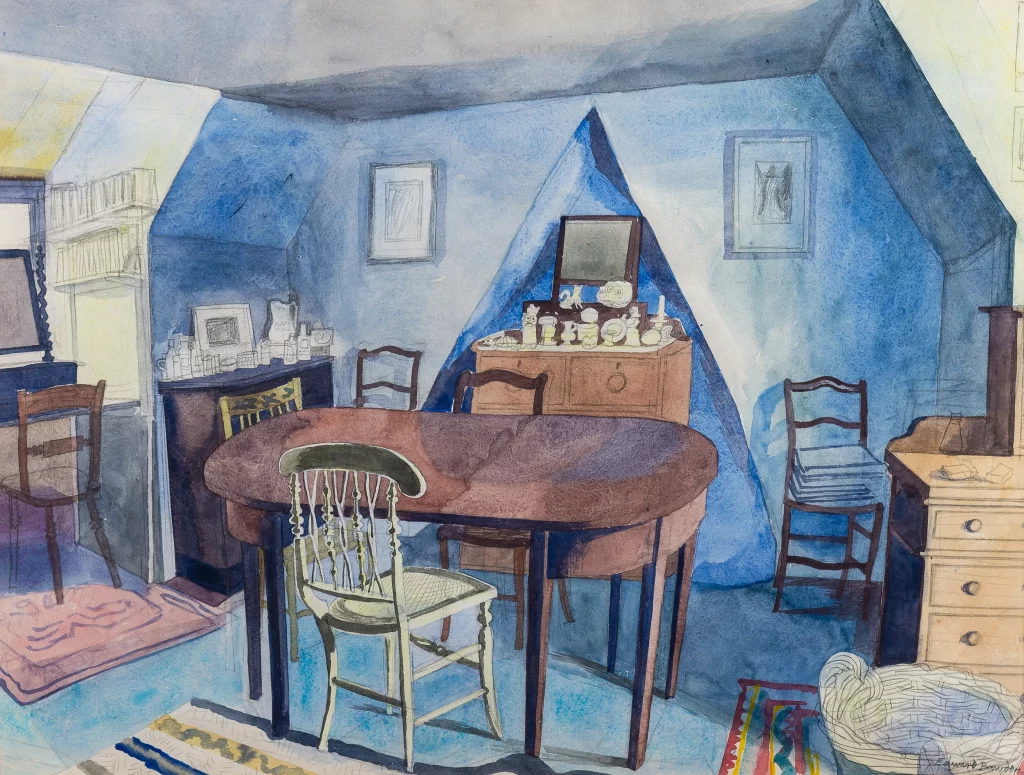
Edward Bawden – The Grandchild’s Room, 1984
Walter Hoyle is in danger of being one of the forgotten Great Bardfield artists due to the lack of information on him.
Hoyle was born in Rishton, Lancashire in July 1922. Hoyle’s artistic
education started at the Beckenham School of Art in 1938,
I persuaded my local art school to accept me, and presented as evidence of my serious intent, a series of drawings much influenced by Walt Disney. †
From Beckenham, Hoyle gained a place at as a student at the Royal College
of Art from 1940-42 and again from 1947-48 after serving in the
Second World War. During Hoyle’s time at the RCA one of his tutors was
Edward Bawden, who encouraged him to develop watercolours and
printmaking.
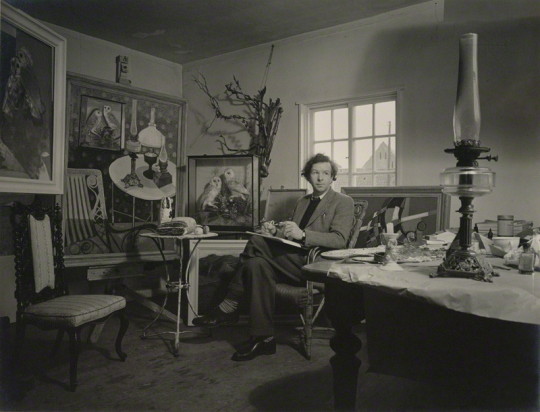
Walter Hoyle at home in Great Bardfield, NPG, taken by Geoffrey Ireland.
It was 1940, the phoney war was to about to end and the college was evacuated from London to Ambleside in the Lake District, famous for poets rather than artists. It was here that I was first introduced to printmaking – lithography – by a friend called Thistlethwaite, a fellow student from Oswaldtwistle (although these names are true, I mention them only because I like the sound they make). He prepared a litho stone for me with a beautiful finely ground surface and instructed me how to draw in line and wash. †
In 1948, During the RCA Diploma show, a visitor was so impressed by Hoyle’s work that he was offered seven months’ work in the Byzantine Institute in Istanbul, Hoyle accepted, the work he saw there made a strong impression. Italian art and architecture also influenced him at that time.

Walter Hoyle – Church Moon, Little Samford (In My Collection) ,1957.
Early in 1951 when Bawden was commissioned by the Festival of Britain to produce a mural for the Lion and Unicorn Pavilion on the South Bank,
it was Hoyle that he chose to assist him on account of his great talent. During that summer Bawden invited Hoyle on a holiday to Sicily.
Edward asked to see my watercolours. He looked very carefully and quizzed me about them, and in general was complimentary and encouraging. I felt I had passed some kind of ‘examination. ♠
It was this holiday together that Hoyle would scribe into a limited edition booklet of 10 in 1990 and into a book in 1998 – “To Sicily with Edward Bawden” a limited edition of 350 copies with a forward by Olive Cook.
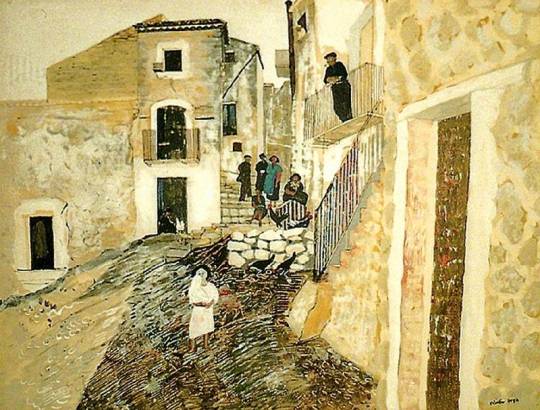
Walter Hoyle – Hill town in Sicily, ex Cambridge City Council, 1951.
In 1952 Hoyle took over the painting of another mural, the dome of St Mary Abchurch, London. The church had been blitzed in September 1940,
and the original mural was being restored by E. W. Tristan, but when Tristan died, Hoyle completed the work. ‡
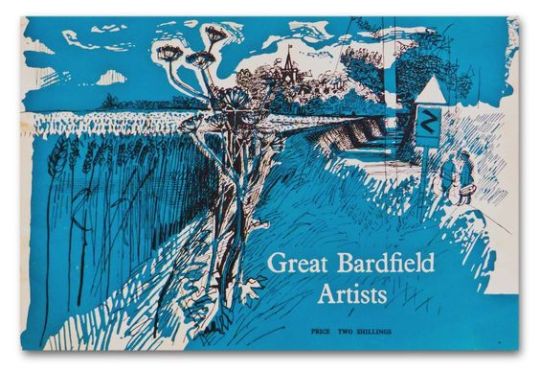
Walter Hoyle – The cover for the Great Bardfield Exhibition booklet.
The move to Great Bardfield:
Hoyle moved first to Great Bardfield in 1952, living for a time in a farm cottage on the outskirts of Bardfield near Great Lodge Farm. He lived and worked in the Great Bardfield area for twenty-two years and exhibited with the Bardfield artists in 1954, 1955 and 1956 when they would open their houses to the public for one weekend a year, rather than relying on London galleries. Hoyle met his wife, the ceramists and poster designer
Denise Hoyle at at one of the Great Bardfield “open house” exhibitions in 1956, when his work was on show at George Chapman’s house.
It may have been Edward Bawden’s painting classes and lectures at Brick House, or being in the hilly Essex countryside but it around this time that Hoyle became interested in English romantic painting: the work of Turner, Blake and Palmer and also in French art. Like other members of Great Bardfield, Hoyle designed for interiors with wallpapers and fabrics for Coles, Sandersons and the Wallpaper Manufacturers Limited.
One of Hoyle’s most popular works for book illustration came with a commission for the Folio Society in 1968 with Shirley by Charlotte Bronte.
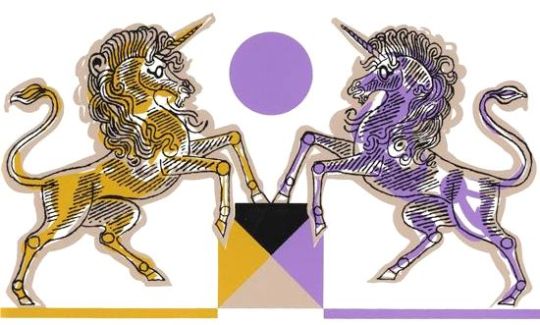
Walter Hoyle Design for Sandersons
Teaching:
Walter Hoyle has taught at various art schools: St. Martin’s, London, 1951-60; the Central School of Art, London, 1960-64; and the Cambridge School of Art, 1964-85.
Walter Hoyle left Great Bardfield and moved to Bottisham, Cambridgeshire, to teach at the Cambridge School of Art in their printmaking department. While at Cambridge, he launched the Cambridge Print Editions, publishers of the magazine of the Cambridge School of Art, “Private View” co-edited by Warwick Hutton, which he started and which included interesting extracts from the work of famous artists and writers such as Patrick Heron and Edward Ardizzone, as well as articles by
students and graduates of the school.
Hoyle took over the collection of ‘Original Works for Children in Cambridgeshire’, an art project for City of Cambridge Committee for Education. Hoyle donated a picture and convinced other artists to give works to the project too. He retired from teaching in 1985 to move to Hastings and Dieppe. Hoyle died in 2000.
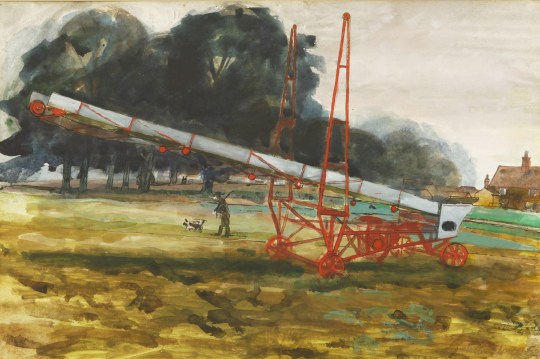
Walter Hoyle – Great Lodge Farm, 1952 (In My Collection)
Exhibitions and Collections:
Hoyle exhibited internationally working outside of the Bardfield set. Exhibitions were not only at the Byzantine Institute Gallery in Paris in 1950, but in 1952 he showed at the Leicester Galleries, London. He was featured in many mixed exhibitions in London and the provinces, including the Royal Academy summer exhibitions and Kettles Yard, Cambridge (1972). Walter Hoyle is represented in many public and private collections, among them the Bibliothéque Nationale, Paris, the Victoria and Albert and the British Museums, the Tate Gallery, the Walker Art Gallery, the Whitworth Art Gallery, the Fitzwilliam Museum, the Sheffield Art Gallery, the Manchester City Art Gallery, Editions Alecto Gallery, London, and the Palace of Westminster and the Fry Art Gallery in Saffron Walden.
He painted murals for the Natural History Museum, for the Jamestown Festival, USA, and for the Sealink ship “St. David”.
Editions of his prints have been commissioned by Editions Alecto, Christie’s Contemporary Art, Neve International, the British Oxygen Company, the Folio Society and St. Catharine’s College, Cambridge.
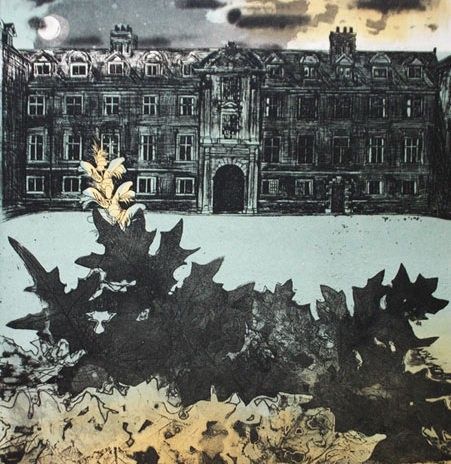
Walter Hoyle – St Catherine’s with Acanthus, (In My Collection), 1966
† Printmaking Today, Volume 7, 1998. page 9-10.
‡ https://en.wikipedia.org/wiki/St_Mary_Abchurch
♠ To Sicily with Edward Bawden, Previous Parrot Press, 1998.
The Great Bardfield Exhibition by Gerald Marks, Realism, August —
September 1955
♣ http://www.fryartgallery.org/the-collection/search-viewer/691/artist/15/Walter-Hoyle–/22
In the short time that Eric Ravilious was of working age he produced a massive amount of work for such a young man. He died while serving as an official British War Artist when the aircraft he was aboard crashed off Iceland. He was 39 years old.
At the time of Ravilious’s death there were various projects underway that the war disrupted. As manufacturing was halted, these commissions were put on hold while the country had to economise.
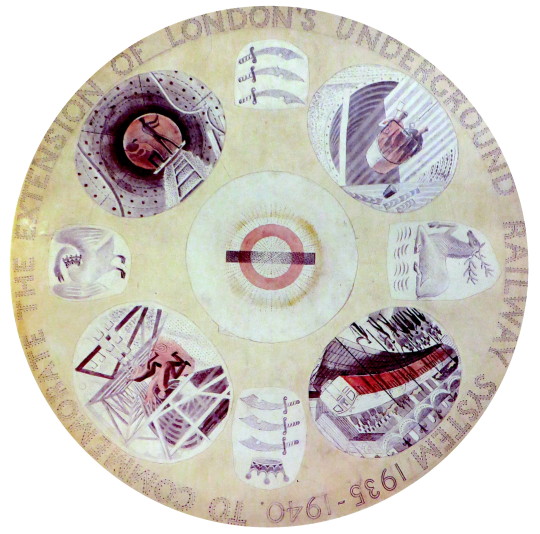
Eric Ravilious – Design for London Underground Plate, 1939.
One of the projects Ravilious had started was for a commemorative plate for the ‘New Works Programme’ of 1935-40 that London Transport had begun.
It was an ambitious extension of the Northern and Bakerloo lines northwards, and the Central line both east and westwards. Although the engineering work was well advanced by the outbreak of war, the project had to be abandoned and was only partly realised in the post-war years. Thus the commemorative plate designed by Ravilious was never produced.
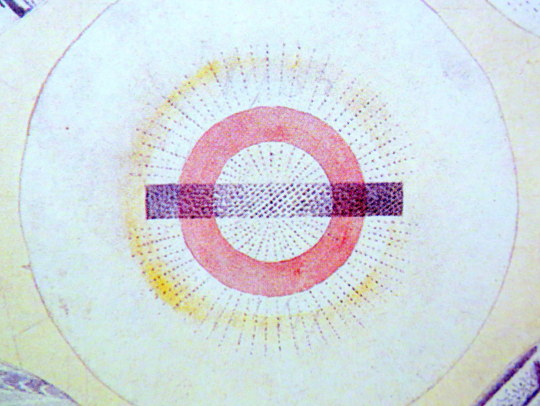
The early Underground train lines, originally owned by several private companies, were brought together under the ‘Underground’ brand in the early 20th century and eventually merged along with the sub-surface lines and bus services in 1933 to form London Transport under the control of the London Passenger Transport Board (L.P.T.B.).
The ‘New Works Programme’ was to develop many aspects of the public transport services run by the L.P.T.B. and the suburban rail services of the Great Western Railway and London and North Eastern Railway.
The investment was largely backed by government assistance as well as by the issuing of financial bonds and was estimated to cost £42,286,000 in 1936 (approximately £2.59 billion today).
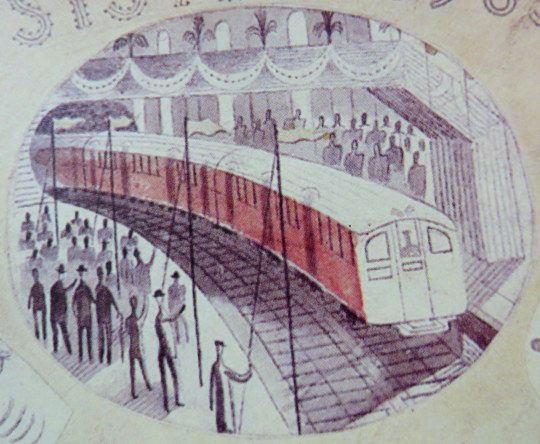
Of the four vignettes Ravilious chose, three were of construction and one was of the predicted Grand Opening, with a tube train and swash bunting along the platform.
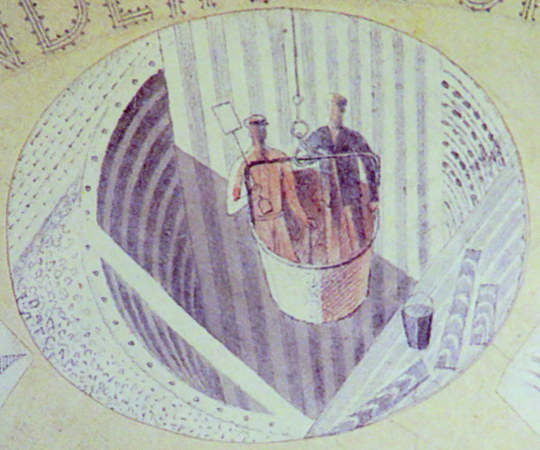
One of the vignettes of construction show men being lowered in buckets into the tube shaft. These were likely non-station locations where the soil was excavated out and the steel and concrete lowered in, like the workers. It was a typical practice in mining.

Men in a small-scale drop lift.
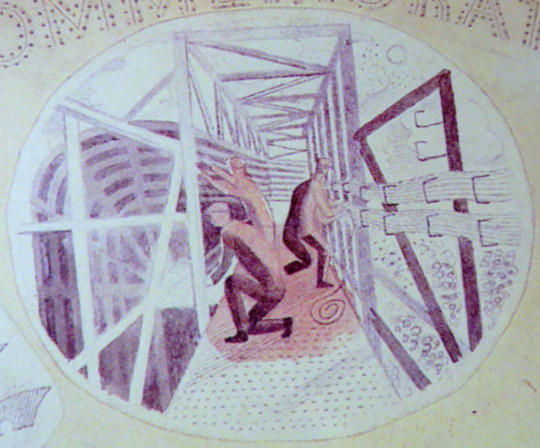
Another of the pictures shows workers putting up the frames for the tube tunnels and station platforms. The wiring being bunched on the sides of the tunnel.
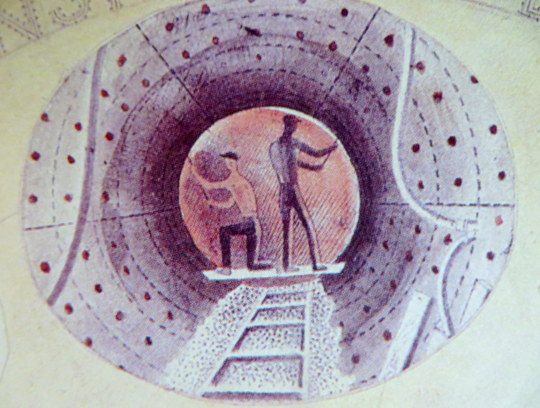
The two workers pictured here are bolting the rivets of the metal into place. The image when manufactured, would have been a black and white transfer and the colour would have been a translucent enamel paint.
The three heraldic devices show the county badges of Essex, Hertfordshire and Middlesex.

Middlesex Heraldry
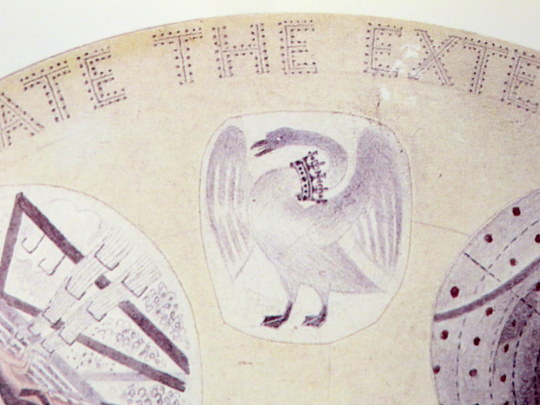
Buckinghamshire Heraldry
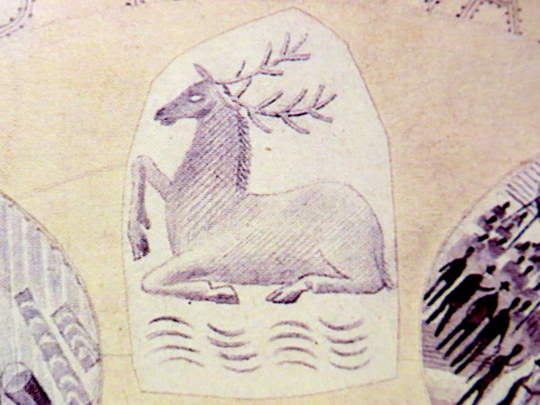
Hertfordshire Heraldry
The plate would have been one of the last commissions of Frank Pick, chief executive of the London Passenger Transport Board. Pick, who retired in 1940 and died the next year, had worked for the Underground since 1906.
Pick had become publicity officer responsible for marketing and it was at this time that, working with the company’s general manager Albert Stanley, he began developing the strong corporate identity and visual style for which the London Underground later became famous, including the introduction of the ‘Underground’ brand.
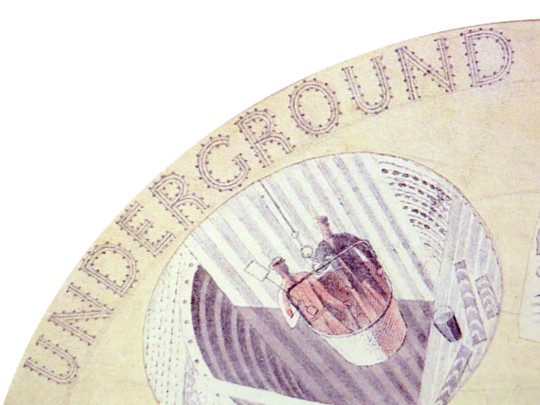
One of Pick’s responsibilities was to increase passenger numbers, and he believed that the best way to do so was by encouraging increased patronage of the company’s services outside peak hours. He commissioned posters which promoted the Underground’s trains and London Transport buses as a means of reaching the countryside around London and attractions within the city. Throughout Pick’s career his over-riding passion was for architecture and design, and his adventurous approach and choice of collaborators is famous.
Ravilious had other work planned for London Transport, some posters and wood engravings. During his lifetime he did see some of his work used, a set of his wood-engravings were used for the covers of the Country Walks books in 1936.
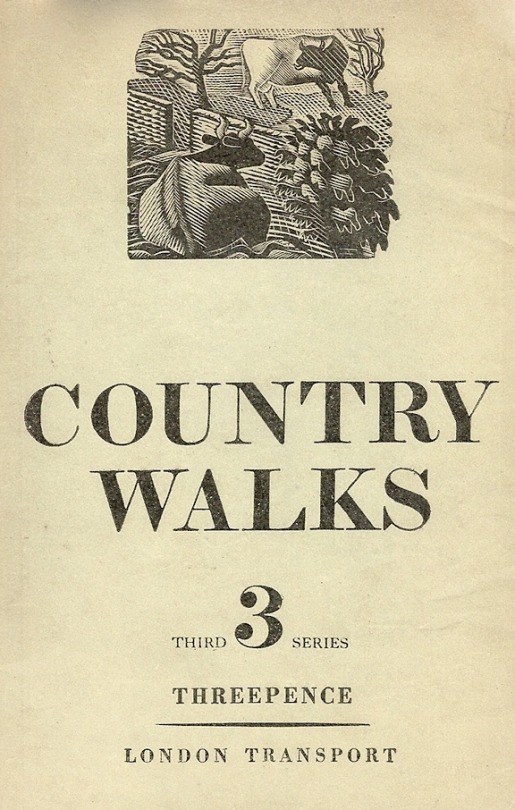
1936 cover to Country Walks, 3rd Series with a Ravilious Design of Two Cows.
The Country Walk books were by Charles White and printed for London Transport to show people the possibilities of using the Underground and Bus network. Inside they had maps and planned walks showing how to get to the locations using London Transport.
Each of the three volumes had a wood engraving by Ravilious on the cover. The second volume had a Mill, the third featured the Two Cows wood-engraving.

A print from the original woodblock with Two Cows to the left, and Hull’s Mill, Castle Hedingham to the right. 1935.
The two images were engraved on the same block of wood and printed together as one proof. On the left a cow and a bull in a field, separated by a stone wall; on the right a horse standing next to a mill stream, with watermill (based on Hull’s Mill, Castle Hedingham, near Great Bardfeild) in the background.
Below is the original drawing for Two Cows, reversed in design as a woodblock always prints backwards.
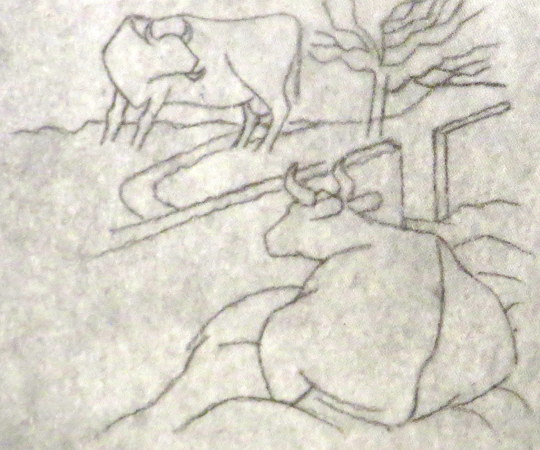
Eric Ravilious – Two Cows, preliminary study for a woodcut, 1935.
The pencil design is remarkable for another reason: part of the design was turned into a watercolour featuring two Cows in the same pose.
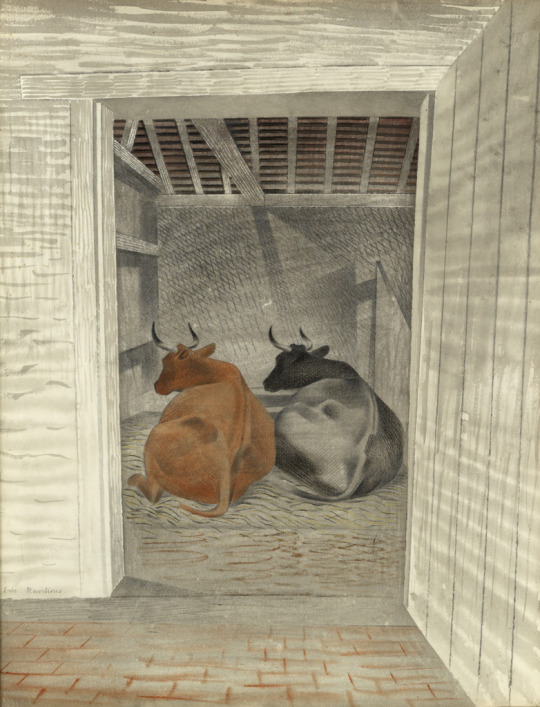
Eric Ravilious – Two Cows, The Fry Gallery, 1935.
The book Away We Go by Oliver Green and Alan Powers, documents more of the other work that both Eric Ravilious and Edward Bawden did for London Transport, mostly their designs for press adverts.
Ravilious Engravings by Jeremy Greenwood, The Wood Lea Press, 2008.
Moving Metropolis by Sheila Taylor and Oliver Green, Laurence King, 2001.
Ravilious and Wedgwood by Robert Harling, Dalrymple Press, 1986
There are many examples where book design is uniform, most famously Penguin Book’s ‘Stripe’ design by Edward Young and perfected by Jan Tschichold in 1935. Bold and colourful they were enormously successful and cheap to make being paperback. The colours they used to coordinate the books also made selecting a book a quicker process due to your preference, Crime-Green. Fiction-Orange. Cerise-Travel. Blue-Biographies. Red-Drama.
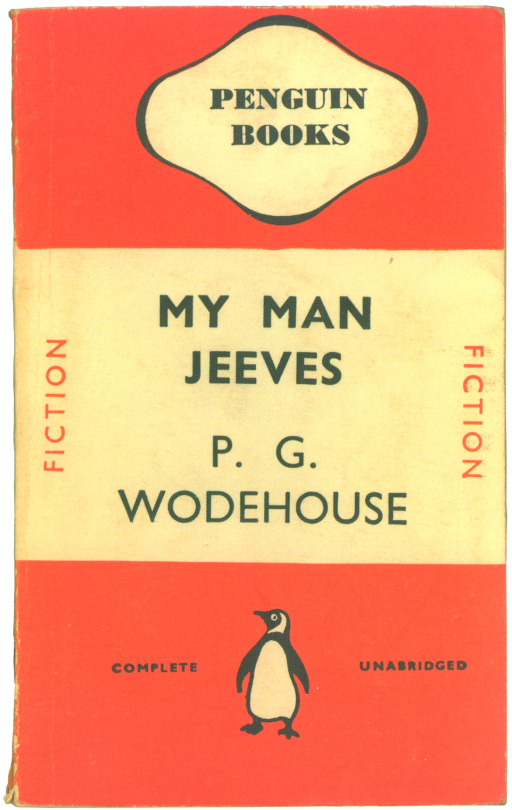
There where many other sets imitating Penguin’s success, most of them short lived. Below is a range of book jackets that Edward Bawden and Eric Ravilious had been commissioned to do, but this time in hardback.
Edward Bawden & The Vanguard Library

The Vanguard Library (not to be confused with Vanguard Books, a US series from the 1930s) was a joint venture published by Chatto & Windus in association with William Heinemann Ltd. The joint venture was probably to combine the backlist of titles under copyright to both of these smaller publishers. The series was in print for only a few years in the early 1950s. The series consisted of back catalog titles, mostly modern fiction, a smattering of more and less serious fiction. †
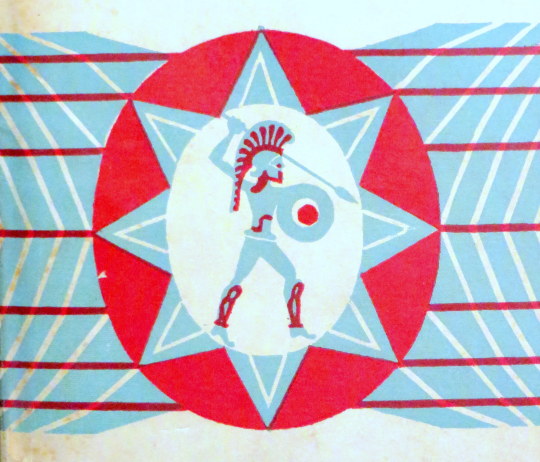
The dust jacket of the Vanguard Library books originally featured a standard design by Edward Bawden of a Trojan warrior on a geometric background.
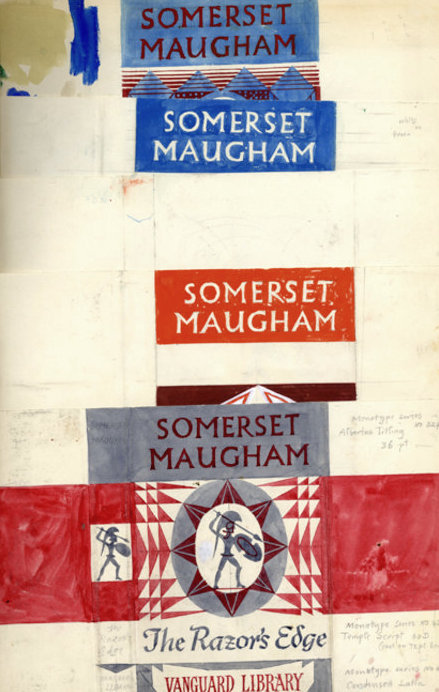
A page from Bawden’s Sketchbooks showing the designs being worked upon.
Although the series would go on with various designs and dust jackets, it is estimated that only twelve books with Bawden’s covers where issued, all in 1952 with his Trojan design but with colour variations.
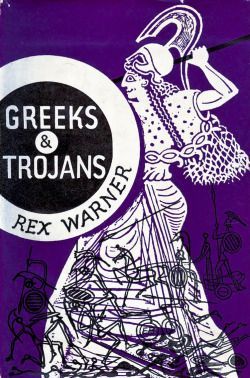
The inspiration for the Trojan design is likely to have come from another book illustration commission Bawden had completed the year before, illustrating Rex Warner’s ‘Greeks & Trojans’.
Ravilious & Everyman’s Library
The series Eric Ravilious was commissioned to re-design was to run far longer than Bawden’s. J. M. Dent and Company began to publish the ‘Everyman’s Library’ series in 1906. It was conceived in 1905 by London publisher Joseph Malaby Dent, whose goal was to create a 1,000 volume library of world literature that was affordable for, and that appealed to, every kind of person, from students to the working classes to the cultural elite.
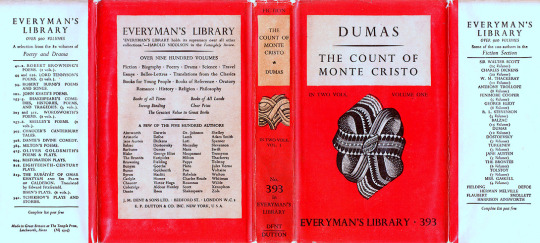
An Everyman’s Library book with Ravilious’s designs to the cover 1935-45
After running for thirty years and likely with the new release of Penguin paperback books, the series went under a redesign in 1935. Eric Ravilious was asked to redesign the covers, end-papers and make graphic devices for each subject that would also be colour coordinated with the dust jackets, like penguin books were. Both publishers where aiming for the same thing, cheap books for the people.
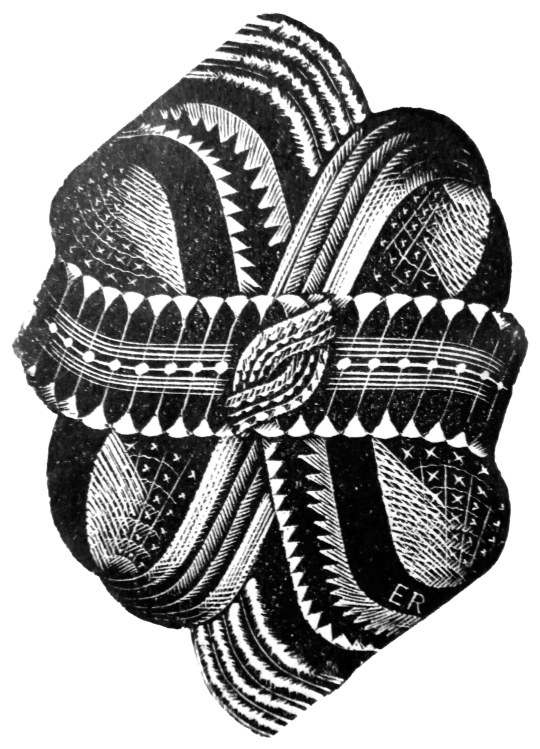
Above is the decorative knot used on the front covers of the books from 1935-1945. Signed ER in the corner. The carving on the top and bottom spikes seemed to lack some detail that would be expected from his normal standard. In two letters to his lover Helen Binyon, Ravilious writes about how the work is rushed and from all accounts takes three months from January to March:
3rd February 1935
…Dents have sent along a proof of the new book which is bad but not very bad, and I am hoping at the eleventh hour to do part of the job again. Unfortunately there is a hurry for it. ‡
21st March 1935
…Everyman is out at last, and seeing six new volumes this morning they looked alright – the one blue Chesterton even rather good. ‡
Below are a selection of some of the dust-jacket colours and devices used for the different subjects and featured on the title page of the book. Perplexingly the designs are not featured on the book spines:

Left to right is Oratory (Red), Reference (Pink), Romance (Orange), Poetry & Drama (Green).

Left to right: Science (Grey Blue), Young People (Bright Blue) Travel and Topography (Green), Essays & Bells-Lettres
Looking at the devices under magnification, there is every evidence that the engravings were made in a considerable hurry with engraved lines carrying on where they should have stopped and inadequate clearing of background details, none the less they represent a considerable imaginative achievement and are most effective. ‡
From 1945, the abstract knot was replaced on some volumes with a clam-shell like design overlaid with an ‘EL’, and from 1951 it was used on most jackets until the design was replaced in 1953.
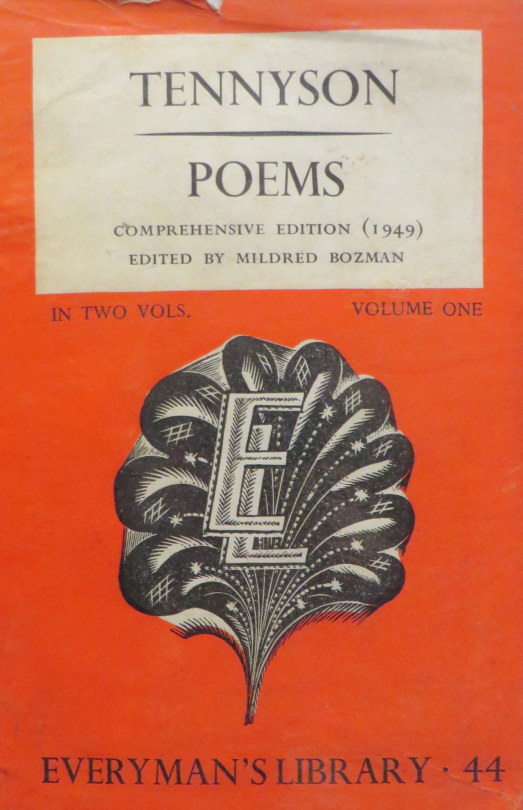
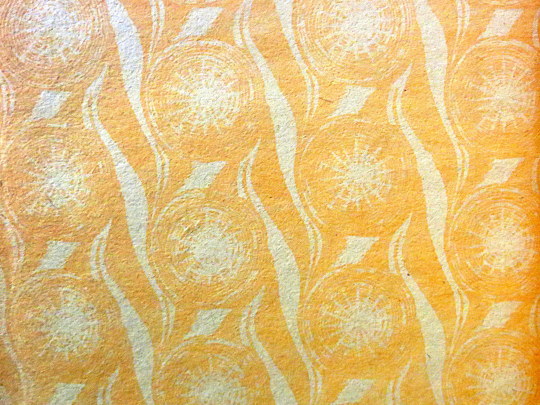
A section of the end paper, with a star like repeat design by Ravilious for the series, it was used from 1935-1953.
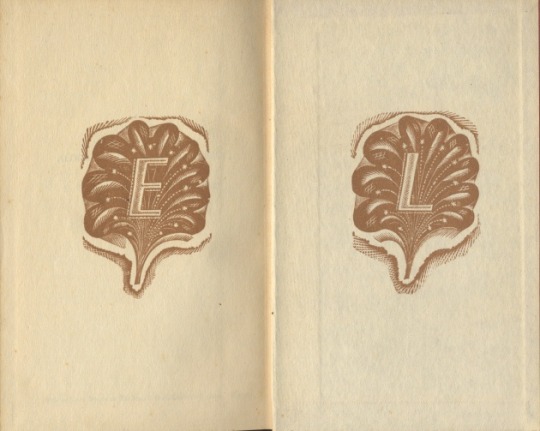
An alternative end-paper that was briefly used in 1935 but suspended for the star patterned paper above.
† Vanguard Library http://seriesofseries.owu.edu/vanguard-library/
‡ Ravilious – Engravings – Jeremy Greenwood
♠ Everyman’s Library: The Ravilious Era http://www.everymanslibrarycollecting.com/ravilious.html
Here are a set of adverts out of various magazines from 1932-34 for the Westminster Bank. They are very similar in style to the adverts running at the same time by Guinness and Twinings. The first four illustrations are by Edward Bawden, then Ardizzone and Rothenstein.
There are many more illustrations with all the artists work on the internet but these were the ones I had found in my magazines so far, the text and pictures show the spirit of the age with travel and empire; to the technology of cars and steam liners, simple but beautiful I think.
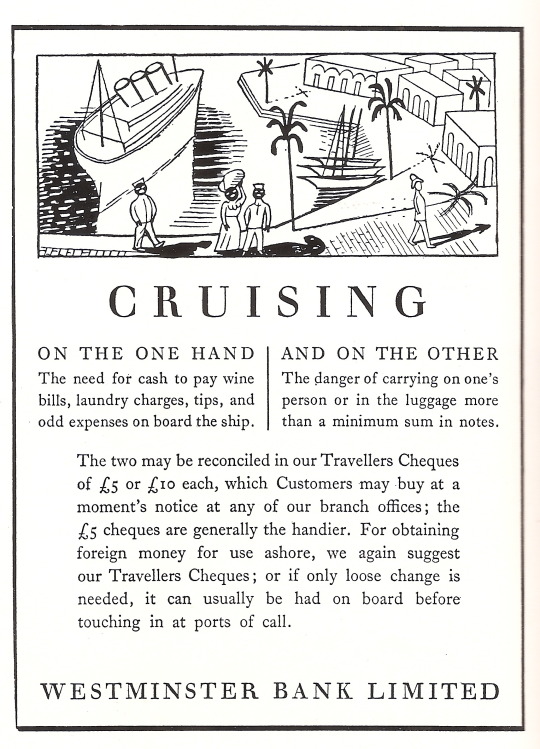
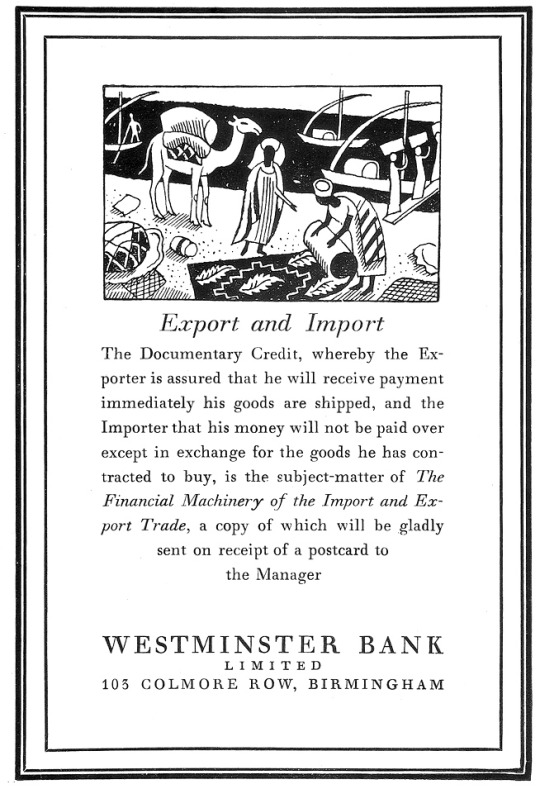
The Documentary Credit, whereby the Exporter is assured that he will receive payment immediately his goods are shipped, and the Importer that his money will not be paid over except in exchange for the good he has contracted to buy, is the subject-matter of The Financial Machinery of the Import and Export Trade, a copy of which will be gladly sent on receipt of a postcard to the Manager.
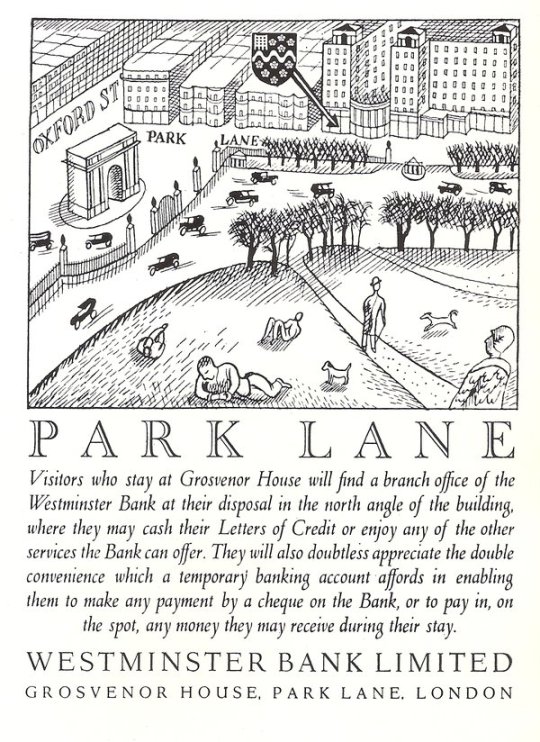
Visitors who stay at Grosvenor House will find a branch office of the Westminster Bank at their disposal in the north angle of the building, where they may cash their Letters of Credit or enjoy any of the other services the Bank can offer. They will also doubtless appreciate the double convenience which a temporary banking account affords in enabling them to make any payment by cheque or the Bank, or to pay in, on the spot, any money they may receive during their stay.
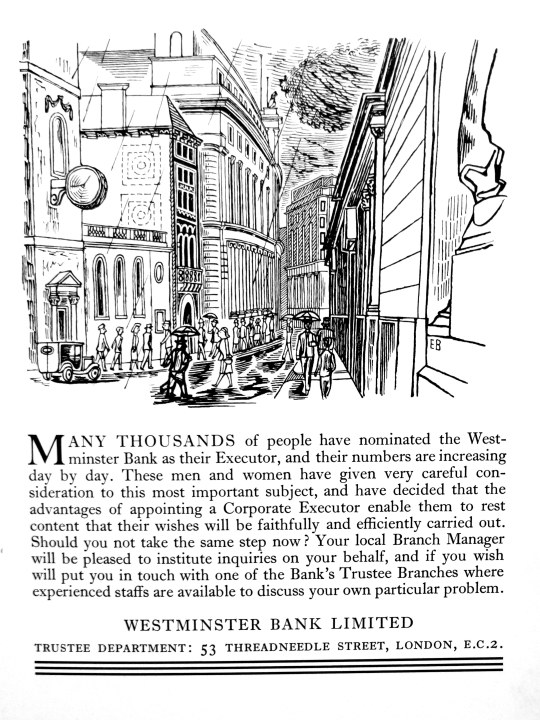
Many thousands of people have nominated the Westminster Bank as their Executor, and their numbers are increasing day by day. These men and women have given very careful consideration to this most important subject, and have decided that the advantages of appointing a Corporate Executor enable them to rest content that their wishes will be faithfully and efficiently carried out. Should you not take the same step now? Your local Branch Manager will be please to institute inquiries on your behalf, and if you wish will put you in touch with one of the Bank’s Trustee Branches were experienced staffs are available to discuss your own particular problem.
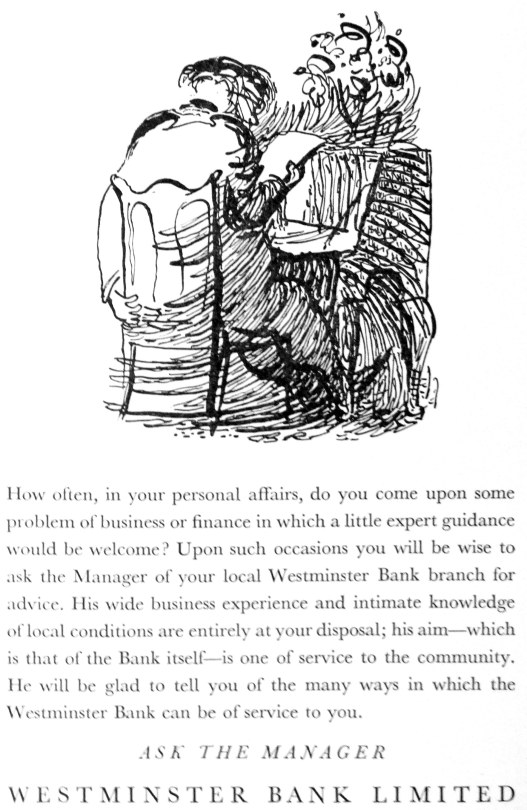
Edward Ardizzone
How often, in your personal affairs, do you come upon some problem of business or finance in which a little expert guidance would be welcome? Upon such occasions you will be wise to ask the Manager of your local Westminster Bank branch for advice, His wide business experience and intimate knowledge of local conditions are entirely at your disposal; his aim – which is that of the Bank it’self – is on of service to the community. He will be glad to tell you of the many ways in which the Westminster Bank can be of service to you.
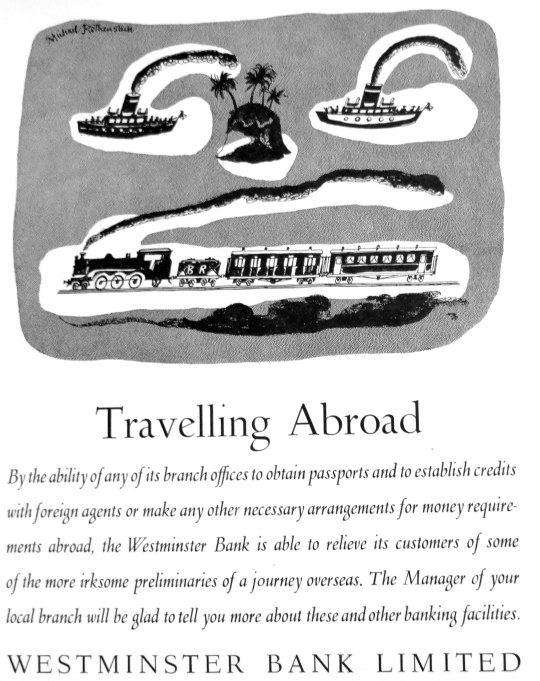
Michael Rothenstein
By the ability of any of its branch offices to obtain passports and to establish credits with foreign agents or make any other necessary arrangements for money requirements abroad, the Westminster Bank is able to relive its customers of some of the more irksome preliminaries of a journey overseas. The Manager of your local branch will be glad to tell you more about these and other banking facilities.
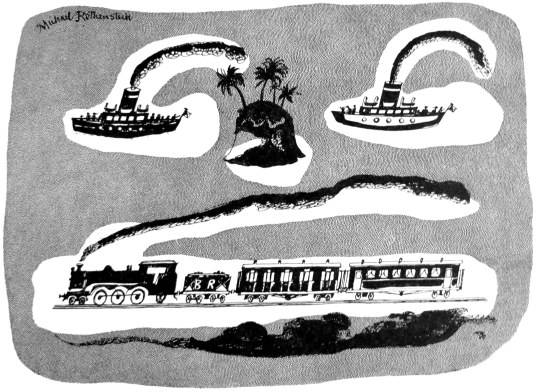
Detail of the Michael Rothenstein illustration.
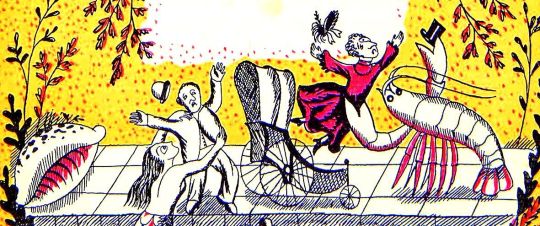
A detail of East Coasting by Edward Bawden
Below is a beautiful limited edition print by Paul Bommer that I own called ‘South Coasting’. It’s inspired by, and expanding upon, Edward Bawden’s illustrations for Dell Leigh’s book ‘East Coasting’.
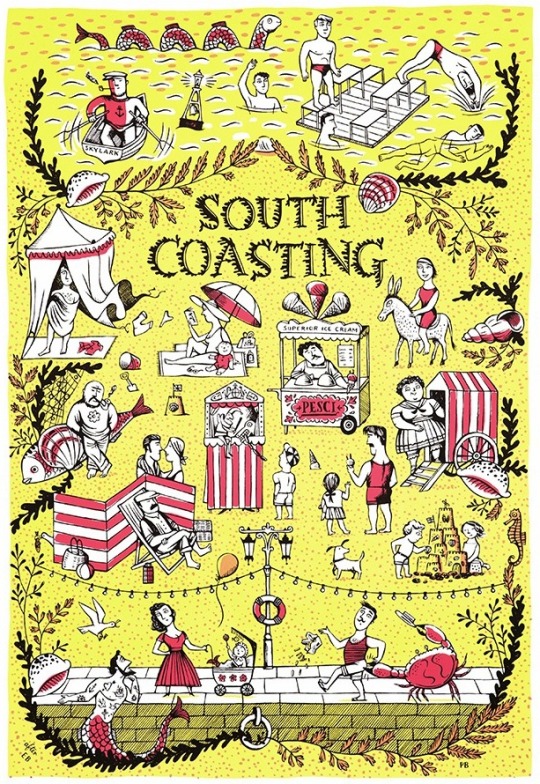
South Coasting by Paul Bommer.
The Bommer ‘South Coasting’ print is an affectionate homage to Bawden’s work as well as an irreverent and joyous celebration of the seaside along Britain’s south coast. Printed in 2013 it’s large at 50cm x 70cm, where as the 1931 Bawden work was just a book illustration.
Written by E.P. Leigh-Bennett under the moniker ‘Dell Leigh’, ‘East Coasting’ was published by London and North Eastern Railways and printed by The Curwen Press.
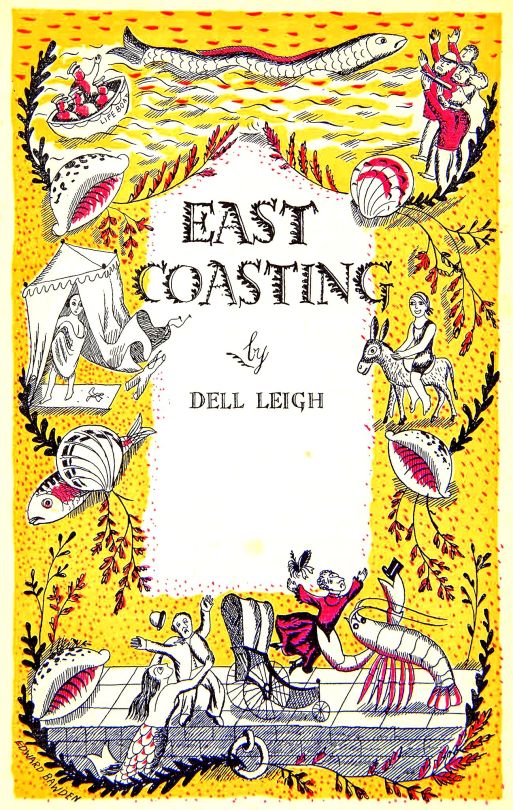
East Coasting by Edward Bawden.
It was a book not to promote the railways, but to promote where they take you. It was an age when the public were using trains for tourism and workers could day trip. Travel companies and unions would offer workers in the city a chance to escape to the countryside.
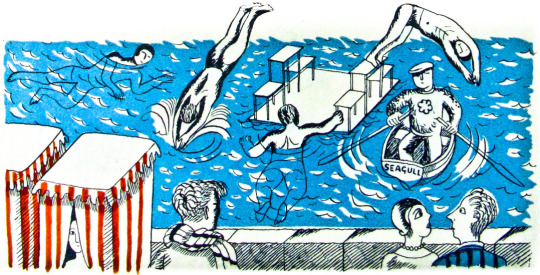
A chapter heading by Edward Bawden.
The railways … helped to boost growth from the 1840s onwards, giving easier, cheaper, faster access to the coast for middling-class families and working-class trippers, and making it possible for Blackpool to become the world’s first working-class seaside resort in the late nineteenth century. By the early twentieth century every English and Welsh coastline was studded with resorts of different sizes, and every possible market could find a congenial holiday home in one or other of well over 100 substantial coastal resorts. †

Paul Bommer’s prints are available here.
† The Seaside Resort: A British cultural export by John K. Walton
